WORLD EDITION
PREVENTING BURNOUT
Ayurvedic ways to relieve stress
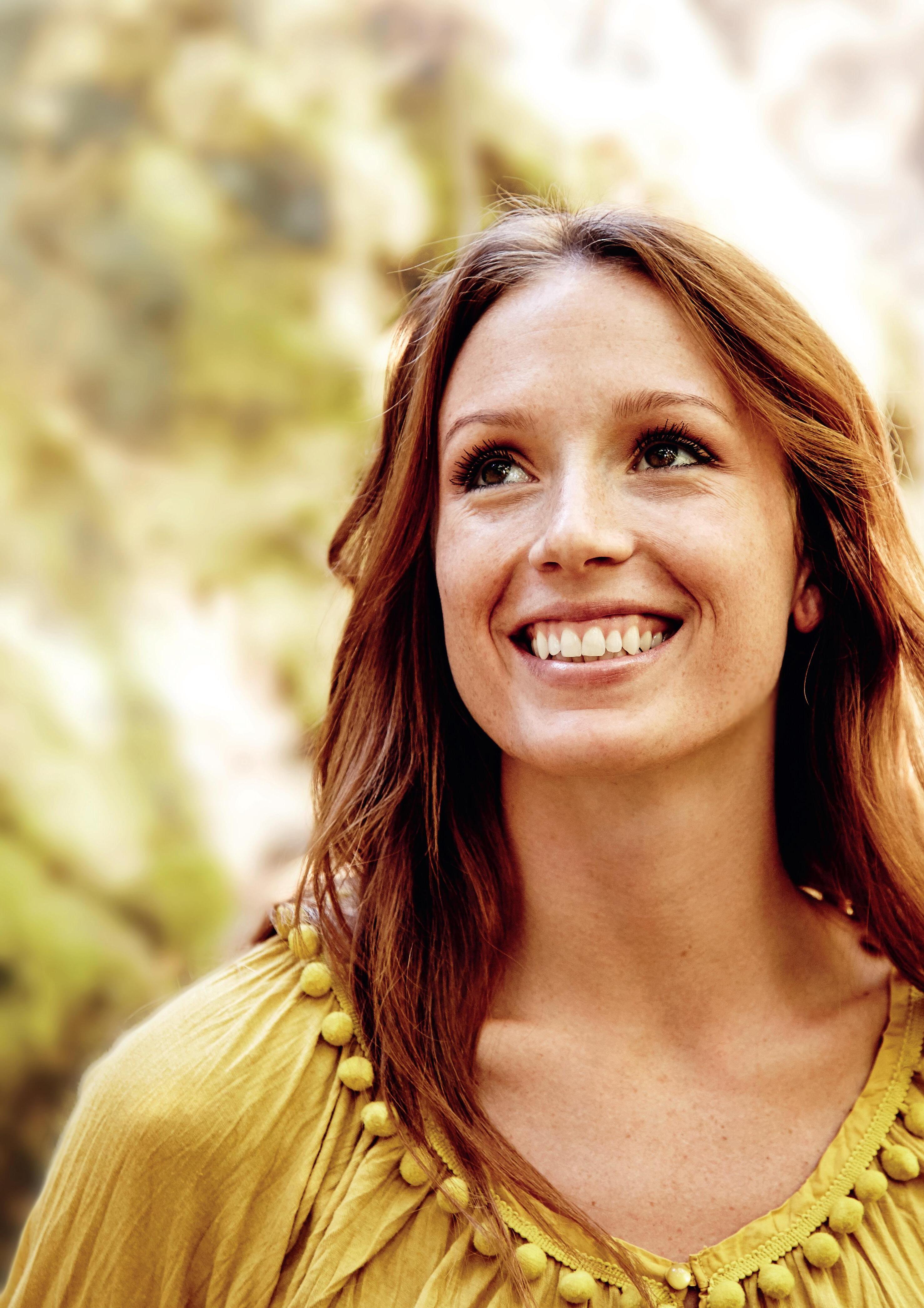
ANCIENT WISDOM FOR MODERN WELL-BEING
Ayurvedic living today
VISION OF THE MEDICINE OF THE FUTURE
Interview with Prof. Bhushan Patwardhan
PULSE READING
recognize yourself
YOGA FOR TRUST
in hard times
as natural health care Worldwide acceptance of Ayurveda 01 Edition 01 – 2022 • September / October / November • Year 01 • 4,90 USD • ISSN 2752-0412 4 262391 470015
In Ayurveda we trust
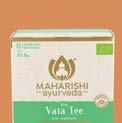
Authentic Ayurveda products since 1987



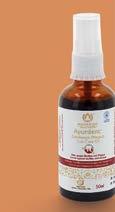


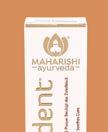














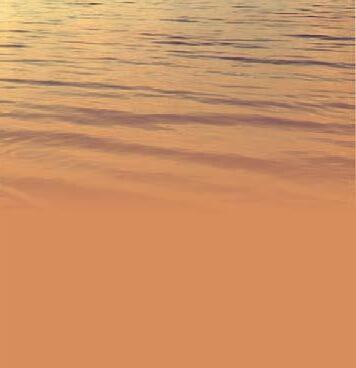
All you need for your daily Ayurveda routine


Oral hygiene and dental care, abhyanga oils, certified natural ayurvedic cosmetics, food supplements, dosha-teas, churnas, spices & much more.
✔ Only first-class raw materials




























✔ Careful, authentic production processes

✔ Original ayurvedic recipes












✔ Free from heavy metals, toxins, pesticides









✔ Non-GMO
✔ Stringent physico-chemical analyses and microbiological examinations by the world’s largest independent control laboratory



Discover now: ayurveda-produkte.eu















Ayurveda works – for me and for others
”Ayurveda is eternal, without a beginning and without an end, because the laws of life are universal in nature and their properties are timeless.“
Charaka-Samhita, Sutr. 30.27
Dear Readers,
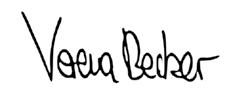
When a medical system has served humanity for thousands of years and constantly evolved in its interaction with the environment, then there is a reason for it. Ayurveda works!
The Ayurvedic texts describe the laws of nature and life. These laws are timeless and eternal. If you free Ayurveda from all the religious and cultural entanglements, it is pure knowledge that can be applied at any time, to anyone and anywhere and therefore still highly modern today. However, this does not mean that we can practice and live the same Ayurveda as 2,000 years ago – many things have changed. The climate, the flora and fauna, the food we eat, our way of life and even genetics. So it is very clear that we have to make adjustments.
For us, this means integrating the old basic principles into our modern lives. Our Ayurvedic lifestyle can be quite pragmatic, adapted to our personal circumstances and modern way of life.
At the same time, there is a need for continuous evidence-based research on the safety and quality of Ayurveda, including Ayurvedic concepts, food supplements, therapies and procedures. This is important to guarantee the effectiveness of Ayurveda as well as to ensure that Ayurveda achieves wide public acceptance.
In this issue, our authors will show you the effectiveness of Ayurveda and the conditions required to make Ayurveda work optimally for you. This will also give you an interesting insight into modern research by which more and more traditional concepts such as the theory of the body's constitutional types – vata, pitta and kapha – are being scientifically proven. We hope you enjoy reading this issue!
Warm regards, Your Verena
Becker
editorial team
and the whole
Verena Becker Editorial management redaktion@ayurveda-journal.de

3 EDITORIAL
03 EDITORIAL
06 LAUNCH: AYURVEDA JOURNAL For a healthier life
By Buko Hartmann
08 INTERVIEW
Vision of the medicine of the future
With Prof. Bhushan Patwardhan
12 PREVENTING BURNOUT

Ayurvedic ways to relieve stress

 By Carina Alana Preuß
By Carina Alana Preuß
16 ANCIENT WISDOM FOR MODERN WELL-BEING
Ayurvedic living today
By Dr. Marc Halpern
22 EVIDENCE-BASED AYURVEDA
New quality standards for effective therapies
 By
By
Prof.
Darshan Shankar
26 BETWEEN SCIENCE AND SPIRITUALITY Is Ayurveda spiritual?
By Verena Becker
36 LEARNING AYURVEDA
THROUGH THE PULS
Nadi vigyan – the Ayurvedic puls diagnosis
By Dr. med. Ernst Schrott
40 MEHNDI
The magical art of henna painting
 By Petra Rascher
By Petra Rascher
4 12 40
08 36 16 CONTENT
John Schlammes
By Ralph Steuernagel
Verena Becker
 Ernst Schrott, MD
By Julia Wunderlich
Ernst Schrott, MD
By Julia Wunderlich

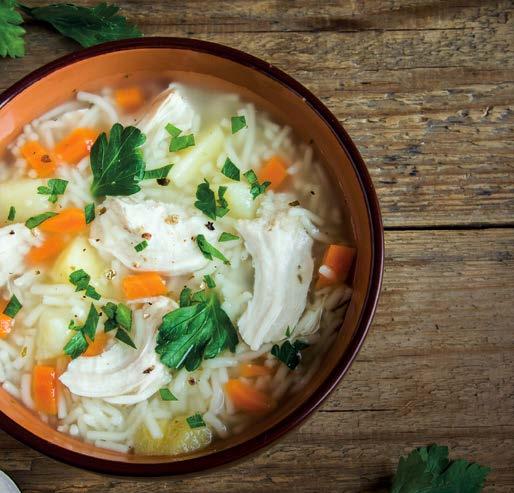

5 63 60 INDIAN FRANKINCENSE 43 Interview with Prof. Dr. H. P. T. Ammon Editorial management YOGA AND TRAUMA 46 Out of the rigidity, back into trust
COLUMN 50 Healing power of Ayurveda
THE COURAGE TO CHANGE 52 What are you waiting for? By
COVID-19 54 Why so few recommendatios for strenghthening the immune system?
NASYA 57 Finally breath free
MEAT 60 Answers beyond yes or no
NOURISHING & GROUNDING 63 Ayurvedic desserts for all three doshas
IMPRINT 66 46 26 CONTENT
By
By
By Wiebke Abel
By Dr. Shubhangee Satam
JOURNAL –for a healthier life”





















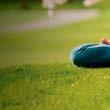
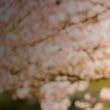

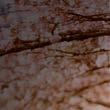
THE BACK STORY
In March 2004 the first issue of this magazine was published in German for distribution in Germany, Austria and Switzerland.


1. Its intention is to transfer the language of Ayurveda and the understanding of Ayurvedic principles to the public in general.

2. It fulfills the international standards of design, content and print quality for a professional magazine.


3. It's available in the high street, selling through stores including supermarkets, bookshops and newsagents and via the app.
4. It has thousands of enthusiastic readers who have subscribed to the magazine for many years.
















5. It provides a platform for Ayurveda businesses to promote their services, business activities, treatments, education and Panchakarma and for local Ayurveda practitioners to promote their services to the public. It’s the main tool of promotion for Ayurveda in German speaking countries.



6. With more than 600 professional articles by eminent authors it is an encyclopedia of Ayurvedic knowledge, covering all branches and applications of Ayurveda. Readers collect the issues and keep them as a source of reference.

Today, in the 18th year of publication and after 74 issues, more than 2 million copies have been printed and distributed. Now we want to export this successful formula to all countries, with an international issue in the English language in print and digital formats.
Buko Hartmann Publisher
6
Ausgabe 02 - 2016 April Mai Juni Jahrgang 12 3,80 (Deutschland), 4,40 (Österreich, Italien, Luxemburg), 6,00 CHF (Schweiz) ISSN 1613-3102 DETOX ALLERGIEN & ASTHMA AMLA Entschlacken im Frühling Ursachen und Behandlung Die königliche Frucht DIE PULSDIAGNOSE Der Rhythmus des Lebens DETOX-REZEPTE HONIG Fit in den Frühling Seine Rolle im Ayurveda 49 YOGA FÜRS HOMEOFFICE Aktiv durch den Tag WINTER-WELLNESS zum Verwöhnen für daheim FESTLICHE REZEPTE für mehr Lebensenergie 68 Ausgabe 01 2021 Dezember Januar Februar Jahrgang 17 4,90 (Deutschland), 5,90 (Österreich, Italien, Luxemburg), 7,70 CHF (Schweiz) ISSN 1613-3102 KREBS ayurvedisch begleiten HARMONISCH UNTER EINEM DACH Ayurveda in der Familie LEBEN MIT PANDEMIEN An der Krise wachsen Gesund durch den Winter LAUNCH AYUS PUBLICATIONS E.K. GERMANY IS LAUNCHING Ausgabe 02 2019 März April Mai Jahrgang 15 3,80 € (Deutschland), 4,40 (Österreich, Italien, Luxemburg), 6,00 CHF (Schweiz) ISSN 1613-3102 61 Ayurveda in YOGAPRAXIS IM FRÜHJAHR Lebensgeister wecken AYURVEDISCH FASTEN DAL-REZEPTE WERTVOLLE HÜLSENFRÜCHTE Auf den Konstitutionstyp kommt es an Köstlich und entlastend Kleine Linsenkunde KUREN IN EUROPA Entspannen und regenerieren Cover-Vorderseite DIE AYURVEDA HAUSAPOTHEKE 10 JAHRE AYURVEDA JOURnAl MEgATREnD gESUnDHEIT ZURücK InS glEIcHgEwIcHT gRüSS MIR DIE SOnnE! Hilfe zur Selbsthilfe mit vielen Kräutern und Gewürzen Ausgabe 02- April Mai Juni Jahrgang 10 3,80 (Deutschland), 4,40 (Österreich, Italien, Luxemburg), 6,00 CHF (Schweiz) ISSN 1613-3102 41 Ein Gespräch mit dem Gründer Buko Hartmann Eigenverantwortung im Fokus Stresssituationen bewältigen Yoga: Der Sonnengruss Häufige Beschwerden ayurvedisch behandeln Die Hausapotheke Ausgabe04 2018 September Oktober November Jahrgang15 3,80€(Deutschland),4,40 (Österreich,Italien,Luxemburg),6,00CHF(Schweiz) ISSN1613-3102 AYURVEDA TRAUMZIEL MENTALE STÄRKE MILCHPRODUKTE KÖNNEN WIR UNSEREN CHARAKTER VERÄNDERN? Tipps für die Frau Die richtige Wahl macht's 59 74 Essen Sie sich gesund! Mit ayurvedischer Ernährung zu mehr Gesundheit, Energie und Lebensfreude ANTI-AGING ERNÄHRUNG SCHLUSS MIT HEISSHUNGER –Das hilft gegen die süße Sucht So essen Sie sich jung und vital TOP 7 GEWÜRZE für eine Verdauunggesunde Ausgabe 03 – 2022 • Juni Juli August Jahrgang 18 4,90 (Deutschland), 5,90 (Österreich, Italien, Luxemburg), 7,70 CHF (Schweiz) ISSN 1613-3102 alsErnährung Medizin 73 Randvoll mit Liebe! Wie sie beginnt. Weshalb sie so wichtig ist. Und warum sie manchmal ewig hält. GESUNDES, STARKES HERZ MIT AYURVEDA FIT IN DEN FRÜHLING LIEBESKRAFT DURCH PFLANZEN Die 6 wichtigsten ayurvedischen Aphrodisiaka 10 Ideen, wie Sie jetzt frisch aufblühen Ausgabe 02 – 2022 März April Mai • Jahrgang 18 4,90 € (Deutschland), 5,90 (Österreich, Italien, Luxemburg), 7,70 CHF (Schweiz) ISSN 1613-3102 Love is in the Air NEW! german digital editions
“AYURVEDA
Ayurveda and Yoga – the new way of traveling!
We create sustainable and inspiring vacations for likeminded travelers. Our Yoga and Ayurveda retreats bring new impulses into your life and convey a conscious way of treating our natural and social environment.
NEUE WEGE Stands for:

• Yoga- and Ayurveda retreats since 1990
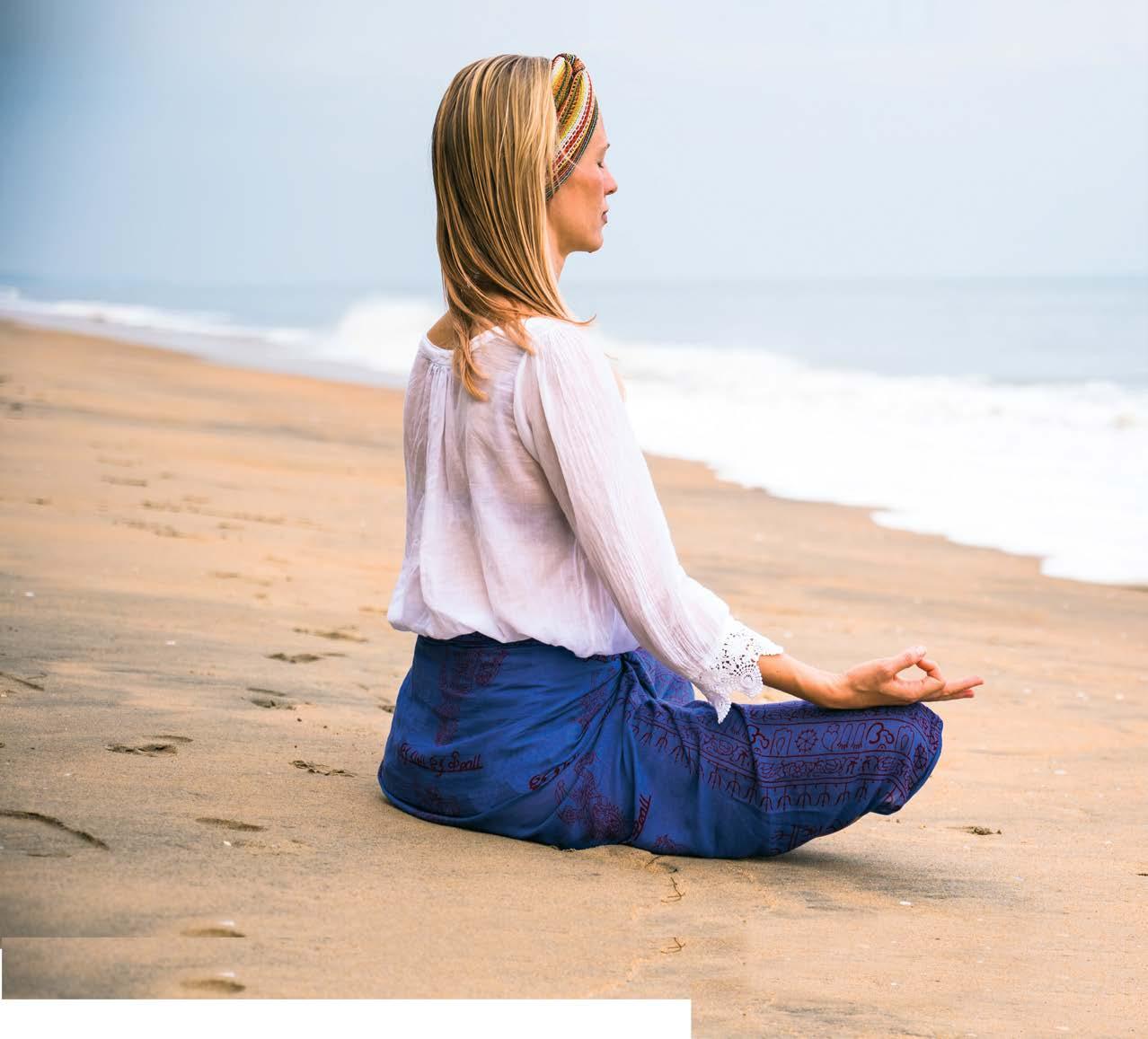
• Sustainable tourism within Europe and Asia
• Many years of experience as retreat operator
• Excellent service and attractive offers
Your Retreat tip
Since 1990
Your specialist for Yoga- and Ayurveda retreats in Asia & Europe
+49 2226 1588-00

@neuewegereisen
www.neuewege.com
Sri Lanka Ayurvie Weligama Resort
Snugly nestled on the cove of a pristine stretch of beach, the eco-friendly Ayurvie Weligama is designed to offer discerning guests an exceptional Ayurveda wellness retreat.
The offer includes:
• Charming Boutique-Resort overviewing the ocean

• Authentic Ayurveda treatments
• Delicacies from its own temple garden
• Practiced sustainability by actively supporting local social projects
15 days starting from 1730 Euro
Vision for the medicine of the future
INTERVIEW WITH PROF. BHUSHAN PATWARDHAN
AYURVEDA JOURNAL (AJ): You originally come from biochemistry - when and why did you decide to devote yourself to Ayurveda?
Bhushan Patwardhan (BP): During my student days I decided to work on Ayurvedic medicinal plants as a part of my doctorate instead of the more coveted fields of protein biochemistry and evolutionary biology. I wanted to understand how the traditional remedies I grew up with work and what the science behind them is. The first lesson I learned from Ayurvedic medicine was: biology does not always work in the way we think and therefore, it is not simply calculable like a mathematical formula.
AJ: Personalised medicine has become an absolute catch phrase. People talk about it as ushering in a new age of therapy. Can the Ayurvedic approach be described as personalized?
BP: Yes, because Ayurveda is uni -
quely patient-oriented. The Ayurvedic doctor diagnoses each patient and treats each patient individually. Both in diagnosis and in prevention, the differences between patients are taken into account. The specific treatment can then also include supportive individual needs, supportive nutritional supplements and dietary and lifestyle counselling to restore the balance, ultimately leading to the elimination of the causes and the disorder.
AJ: You have been involved in personalised medicine for a long time, even before it became a trend. Why is that topic so important?
BP: Twenty years ago I hypothesised that Ayurveda is personalised medicine. Personalised medicine was not yet popular, it was just as little known as pharmacogenomics; the different effects of medicine on patients by innate genetic differences. At that time, it was thought that medicine had the
same effect on everyone. If we gave 500 mg of aspirin to 100 people, this should provide relief for all people. But that is not true – for some it may be too little, while for the others it may cause hyperacidity. We have often tried attributing differences between people to language, culture or geographical differences but these explanations are ultimately insufficient. The three doshas, on the other hand, transcend national borders, language barriers or ethical classifications – vata, pitta and kapha exist in Mongolia as well as in Alaska. This important principle can form the basis of a form of personalised medicine that can help a specific person with specific conditions. Depending on the individual's constitution, maximum therapeutic efficacy and a high degree of safety can be achieved. If we treat every clinical condition with the same therapies and medicines, the treatments are not optimally effective. The importance of individual variations in different populations was emphasised by Charaka several

8 INTERVIEW
hundred years ago as: "Each individual differs from another and should therefore be regarded as a different unit. As many variations as there are in the universe, as many new ones can be found."





AJ: Is there any scientific proof for the existence of genetic differences between vata, pitta and kapha - our individual constitution (prakriti)?



BP: Yes, there is. I decided to test the hypothesis of the prakriti concept on a group of patients with rheumatoid arthritis. The connection between a certain gene (HLA) and arthritis was already known. So we did a randomized blind trial with patients with the so-called HLA DRB1 gene in three groups, vata, pitta and kapha based on the classification of an Ayurvedic doctor. Since the study was blind, we did not know which participants belonged to which group and investigated their variations using a polymorphism study. We were actually able to show that certain alleles (variants of this gene), were distributed differently in vata, pitta and kapha patients statistically. This was the first time that solid scientific proof of the fundamental efficacy of the traditional Ayurvedic system was established. Now there is a new discipline known as ayugenomics. Several research groups are
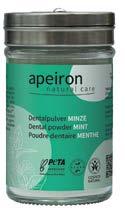

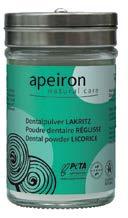
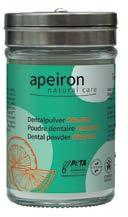
C M Y CM MY CY CMY K 9
digging deeper into understanding the genetic basis of prakriti. However, our understanding of the complexity of Ayurvedic biology is just at the beginning and other profound concepts like agni, rasa, ama or shat kriya kal (the six stages of disease development in Ayurveda) have the power to lead to completely new innovations in modern science and medicine. Imagine what it would mean if shat kriya kal was scientifically proven. We could, for example, identify diabetes much earlier – because the disease process starts much earlier than when high glucose levels are seen in the blood. This knowledge would form the basis for a completely new medical science.
AJ: Is there any other evidence that supports the concept?

BP: Even though these results only provided initial indications, they warranted further experiments on the prakriti concept. The Ayurvedic descriptions indicate that people with pitta constitution are fast metabolisers while people with kapha constitution are slow metabolisers. We put forward the hypothesis that different constitutional types metabolise drugs at different rates. Our studies could actually show that there is a probable genetic basis for these metabolic differences in humans. Such findings are also of great value, of course, for the pharmaceutical industry. It clearly shows that the drugs are not equally effective on all people and in the worst case a patient may have side effects if the individual constitution is not taken into account.
AJ: Is the connection between traditional and modern medicine indispensable to make Ayurveda sustainable?
BP: Yes, the interface between traditional and modern sciences is necessary for a creative dialogue between different medical systems. Today, however, many, if not most students of Ayurveda lack a solid theoretical foundation in both fields. There is insufficient exposure to contemporary disciplines such as public health, cell biology, epidemiology, medical technology, pharmaceutics, clinical pharmacology, immunology and pharmacogenomics, to name but a few. To address these problems, we have an ambitious research capacity building program to establish a group of modern Ayurveda students who are familiar with the richness of the Ayurvedic classics and the insights and knowledge of modern biology.
AJ: What could future medicine look like and what is the role of traditional systems such as Ayurveda?
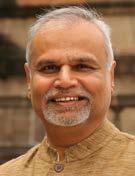
BP: The medicine of the future will be completely different from what from what we know. It will be more inclusive, more humane, gentler and more affordable. This is only possible if we combine modern medicine with scientific knowledge from traditional systems such as Ayurveda and combine the two with each other. This will be the medicine of the future.
Bhushan Patwardhan is founder and editorin-chief of the scientific Journal of Ayurveda and Integrative Medicine (J-AIM), member of AYUSH, national research professor at the Savitribai Phule Pune University and one of the best known personalities in the field of evidence-based ayurveda. He has already received various national and international awards. His work is published in more than 175 scientific publications and has more than 10,000 citations.
10 INTERVIEW
Prof.
Three learning types - one academy


Set up your own training schedule!
Choose from 17 different Ayurveda degrees, e.g. Ayurveda Health Coach, Ayurveda Nutrition Coach or Ayurveda Mental Coach


Get your free taster course!

– in
webinar or
eAcademy Learning Ayurveda
presence , as
in the
www.ayurveda-akademie.org rosenberg.ayurveda Ayurveda Akademie eLearning live webinars presence seminars FREE OF CHARGE INFO DAY with lectures on 16 Oktober 2022
PREVENTING BURNOUT

Ayurvedic ways to relieve stress
by Carina Alana Preuß
Leaving work right now? No, there's still too much to do. Eating in peace? Maybe I’ll do that at the weekend. Sufficient sleep? No time, coffee works just as well. Meditating or exercising in the morning? Sounds good, but currently I'm too tense for that. Reducing stress rather than just building up more? Yes, okay, maybe little more chocolate would help? Spending a relaxing day with your loved one? No, that won't work, we argue a lot at the moment. Turning the phone on in the morning but only from 8 o'clock onwards? Unthinkable, especially as the time in the bathroom and at breakfast is essential for clearing backlogs. Time just for me? No, that's just not possible right now.
DO YOU RECOGNISE YOURSELF?
Have you had that lifestyle once, or even more times, in your life when everything that is good for you faded away and you tried to push your body and mind be-yond their limits? When you are just running so fast through your life that you even turned your back on the things that are important to you, such as your ayurvedic lifestyle or your meditation or yoga time? Because a goal that at this very moment seems to be the most important thing in the world?
THE EGO TRAP
In this situation, your ego has most likely identified with and is entangled in everything that is done in and is relevant to the material world. You see the potential for expansion on this earth tends to the infinite. Thus, there is always a lot to do. Do you really think you are responsible for ALL the work that needs to be done? Exaggerated self-sacrifice and overworking yourself do not help, neither you nor the world. On the contrary, at its worst, it is the direct path to a classic burnout. And if you get burnt out, it's a loss to your surroundings. Because that thirst for action is replaced by listlessness, purpose with meaninglessness, feeling powerful by exhaustion and fatigue, loving work by fear of work, creativity by mental blocks,
12 PREVENTING BURNOUT
quick-wittedness and constructive thinking by feeling inadequate and not up to the challenge, motivation by despair and drive by depression.
If you're about to burn out, it means you've gone full tilt, far beyond the target and put yourself out of action. It´s often very difficult to get out of this state und shift into a lower gear from an advanced stage. At that stage, most of the time, only emergency braking will help. So act in time!
RAJAS SITS ON THE THRONE
Who or what is actually responsible when one is constantly overwhelmed by not acting in moderation? According to Ayurveda, there are three dominant qualities on the mental level. They are weighted differently in everyone and always work together dynamically. Sattva cares about the purity, clarity, awareness, ethics, positivity and peace in the mind. Rajas regulates the activity, motivation, goal pursuit, passions and fighting nature of the mind. Tamas manages the sleepiness, nactivity, ignorance, inertia and unconsciousness of the mind.
If the focus of your life shifts too much towards your intentions and activities and even puts your inner urges on a kind of throne, rajas will chase you from corner to corner like a manic, relentless and restless king, until at some point you drop from exhaustion.
Authentic Ayurvedic treatments in Kerala
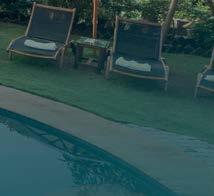
THE RIGHT AMOUNT OF RAJAS
Don't get me wrong, having rajas is wonderful and extremely beneficial, as a rule, for a human being. Professional success would be almost impossible without rajas and we all like a bit of attitude and passion. But it doesn’t help anyone if you make great plans, set everything in motion full of vigour and then topple down on the home straight! Even away from work, in your private life, it does not matter if you sacrifice yourself for your fellow human beings, because ultimately you deprive them of important support should you become sick and unable to help!
MINDFULNESS AS A FIRST PREVENTATIVE MEASURE
Mindfulness is the most basic way to prevent constant overexertion, to keep your strength and vitality and stay in the midst of life. Without carefully observing your own actions and your state of mind and body, you will not notice that you are starting on a dangerous path.
And then comes the hardest part! When you have noticed that rajas is running riot and leads you to believe that, come hell or high water, you need to work even faster and progress even further, then it's very hard, but essential (!), to pull a couple of small ripcords. Otherwise rajas will very quickly pull the big ripcord.
UPTO 30%DISCOUNT ONLINE
Inclusive:
Authentic Ayurvedic Treatments
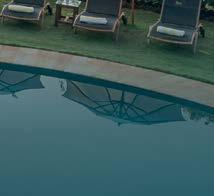


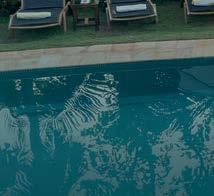
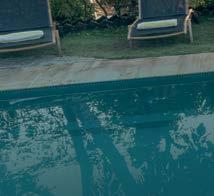

Yoga & Meditation
Ayurvedic Cuisine
Somatheeram is located on the breathtaking Malabar beach in Kerala, India. Our German-Indian management stands for quality and authenticity in Ayurveda. Somatheeram has already been awarded 10 times as „Best Ayurvedic Centre“ in Kerala. The medical team consists of renowned Ayurveda specialists and has been specialising in prevention and the treatment of Western diseases for more than 30 years.
SOMATHEERAM AYURVEDIC HEALTH RESORT WWW.SOMATHEERAM. ORG PREVENTING BURNOUT
SEVEN STRATEGIES TO KNOCK RAJAS OFF THE THRONE
You will probably have to force yourself to put any one of these seven strategies into action but there's no other way of outsmarting your ego and letting your intellect take over.
If you find it too difficult at first, ask a loved one or your colleagues to help you implement these seven strategies. Guaranteed, they will appreciate you downshifting a gear and be happy to support you.
1. Foremost, plan a fixed appointment with yourself of at least one hour every day. Lean back, try to get into a relaxed or meditative state (this needs to happen before the burnout) and seriously ask yourself the following question: what, for me, is really essential?
Also, try to look at your life from a bird's-eye point of view and relate your current state and current situation to a) what your life really needs of you; b) your de facto desired quality of life; c) the entirety of your life, next to which the current project situation in the company or the family problem will, in comparison, look much smaller than they feel to you right now. This way you achieve the necessary distance from your current situation and can ease some of the pressure built up in your mind.
2. Minimise your coffee and black tea consumption or give it up completely. Yes, even if you feel tired for a while as a result. Let's be honest. Despite coffee, tea & co you've surely been tired lately anyway. This caffeine self-denial gives your nervous system some relief and may possibly help you finally to sleep more soundly and for longer.

3. Consult an ayurvedic expert to find out which dietary supplement (medya rasayana) is most suitable for you. It can help to calm your mind a little so you don't drive yourself beyond healthy levels.
4. Give yourself a foot massage in the evening to soothe your mind, to fall asleep faster and achieve sound sleep. Move away from strategy-thinking in the evening and working in your dreams. Instead move towards charging your inner batteries through a quiet and regenerative sleep, which should not, under any circumstances, be disturbed, severely shortened or even omitted during times of stress. Once a week book an ayurvedic oil massage. Preferably in a practice with strict cancellation rules. Your to-do list will be moaning about what you could do in that time but this is to prevent the burnout that will otherwise finish you off, and soon.
5. And while we're on the subject of diaries, only deal with what is essential for your work or your private life, everything else can wait. Create “islands of time” for yourself. Also, be sure to take two days off every week, without exception. Working through is no longer an option, even when the workload increases.
6. Also reduce your overstimulation by enforcing mobile phone bans. The best strategy is to set strict times. For example, do not look at your phone before 8am. The same applies from 8pm onwards. This is the only way to make it possible to fill your “islands of time” with something calming and balancing, to switch off and come back to yourself.
7. Schedule freshly cooked lunches and dinners into your daily work routine to bring maximum regularity. The more structured the framework in which you operate throughout the day, the less you will drain your body’s energies.
Start the deceleration – now!
Carina Alana Preuß
is managing director of the Ayurveda Parkschlösschen in its second generation. She is also an Ayurveda lifestyle coach, yoga teacher and laughter yoga instructor. She published the "My Ayurveda Lifestyle" online course. www.ayurveda-parkschloesschen.de www.mein-ayurveda-lifestyle.de

14 PREVENTING BURNOUT
A pl A ce for longing, comfort A nd he A ling. We W elcome you to the lovechild of the Austri A n fA mily h ollm A nn – t he discoverers, pl A nners A nd builders of this Ayurvedic pA r A dise.
The ancient art of ayurveda in its purest and finest form is what we offer. Accompanied by a team of doctors that curate individualised treatment for each person. Let it be Intense panchakarma? The unique, traditional cleansing cure of Ayurveda will be offered to you in an ambience that is unparalleled.
At Underneath
The Mango Tree we minimise artificial sound while you are receiving your treatment. The surrounding nature provides ambient sounds of the Indian ocean waves and the cooling sea breeze to sooth your soul.
Here, at the southern tip of Sri Lanka, on a hill above the sea, the UTMT boutique hotel is reminiscent of a small village surrounded by coconut trees and mango trees... half a globe away from home and stress of a never ending rat race. The day begins for guests with yoga and meditation which starts your day on a highly positive note.

Breakfast is served on the terrace with a sea view and the culinary crossover of Sinhalese-European cuisine is highlighted in our menu. Don’t miss the grandiose sunsets for dinner, with the hearty laughter of the people at UTMT.
Our rooms and suites are curated to pamper you with thoughtful appointments to fulfil your every need. Unapologetically snuggle up in relaxed recreation on your own sandy beach or on a discovery tour of the island, during detox weeks or just by yourself. Life is Beautiful ...
A yurved A intense 14+2
„ panchakarma“ recharge special at utmt: 14 nights with a yurvedic full board, 4-6 treatments per day, daily yoga & meditation, private beach and pool. o n top 2 nights with halfboard for you to explore the country. We would be happy to make a personal offer: iris rosenzopf, reservations@utmthotel.com
Wala WW atte, Batheegama West,
W ella, s ri l anka +43 5 7778300 ( D eutschsprachig), reservations@utmthotel.com, WWW .crazyhollmann.com utmt sri lanka
Dick
@underneath_ the_mango_ tree D icover all the utmt magic: #utmt #hollmannsrilanka #crazyforyou
Ancient wisdom for modern well-being
Ayurvedic living today
By Dr. Marc Halpern
Ayurveda is a system of medicine that has been practiced for more than 2,000 years. But the ancient knowledge is still valid today – and that is not all. It is more popular than ever before and in the meantime Ayurveda is officially recognized as a system of medicine in 17 countries. More and more people live according to Ayurvedic principles. But what is the reason for this? It is reasonable to assume that they do not decide on Ayurvedic therapies and lifestyle based on the evidence or philosophy but for very pragmatic reasons – therapeutic efficacy. In this article you will learn why Ayurvedic medicine is still up-to-date and effective and which small changes can help us in everyday life to stay healthier in the long term.
16
THE PRINCIPLES OF AYURVEDA ARE TIMELESS AND UNIVERSALLY VALID
Ayurveda works 100% of the time for 100% of the people who apply 100% of the available knowledge. But how is this possible? After all, the roots of Ayurveda lie in the ancient Indian Vedas which were written down several thousand years ago. How can this ancient source of knowledge from another time and culture still be relevant, valid and effective today?
THE LAWS OF NATURE HAVE NO COUNTRY BORDERS
Ayurveda is a paradigm that can be applied worldwide. Although Ayurvedic medicine has its origins in India, it is a universal model of health care based on the laws of nature and the laws of nature have no country borders. Sometimes it seems as if Ayurveda is a form of medicine that only works for the Indian culture. However, this is because the knowledge of Ayurveda is clothed in Indian customs and explained in the regional language of India. Just as every great source of knowledge has to be translated in order to be understood in other regions, the same is true also for Ayurveda. This task falls to those who are versed in the science of Ayurveda. They must find the words to speak to the people within their own culture.
INDIVIDUAL AND HOLISTIC
Ayurveda is a holistic form of medicine that always treats body, mind and soul. Since the cause of disorders usually lies on several levels, ayurvedic therapy always addresses all three levels. At the same time, Ayurveda works highly individually. This holistic and individual approach of Ayurveda ensures that treatments are always adapted to the individual person's environment so that one therapy is never the same as another. The effectiveness of the therapy can be achieved only if these principles are heeded.
POSSIBILITIES AND LIMITATIONS OF AYURVEDIC MEDICINE
Ayurveda works within the framework of what is possible within the laws of nature. When we live in conflict with the laws of nature, our health is affected and we suffer. When we live in harmony with the laws of nature, we maximise our potential for healing.

17 ANCIENT WISDOM
Ayurveda is a holistic form of medicine that always treats body, mind and spirit.
If the imbalance in our body has not yet passed the point of healing within the laws of nature, healing will take place. For this reason it makes sense to start Ayurvedic treatment programs as soon as possible. Because if the disorder is too advanced, Ayurveda can no longer work. When this happens, the heroic methods of modern medicine will be required to intervene. I always tell my students – "If I have a car accident and lose my right arm, don't take me to an Ayurvedic doctor". Take me to a neurosurgeon who will stitch my arm back on. After that I will use Ayurveda to maximise the healing of the tissues. There are limits to what nature can do on its own. No matter how much I live in harmony, I can't grow a new arm.
To prevent disease and maximise the potential for healing, various Ayurvedic practices and principles must be successfully applied. Since only a few people live a perfectly harmonious life, diseases do occur. By living as harmoniously as possible, a person's quality of life is improved and thus also the lifespan.
4
steps for your new beginning with Ayurveda
TAKING NATURAL NEEDS SERIOUSLY
Hunger, satiety, thirst, exhaustion – our body tells us what it needs every day. It is our task to be aware of our needs and to take them seriously. Many people have lost contact with their primary source of experience – the body. Instead of following their natural appetite for food, many people get lost in complicated nutritional theories and become more and more alienated from their own needs. But many imbalances can be prevented simply by starting to pay attention to the signals of our body every day.
ESTABLISH ROUTINES
The Dinarcharya principle in Ayurveda recommends establishing a regular rhythm (sleeping, eating times etc.) in everyday life. The knowledge of your constitution or imbalance can help you to organize your routine in such a way so that it prevents illness and supports healing.

CONSTITUTIONAL ANALYSIS AND THERAPEUTIC SUPPORT
Knowledge of one's own constitution plays a major role in Ayurvedic prevention and therapy. Look for a qualified Ayurvedic therapist or doctor who will work with you to analyse your physical and mental constitution in-depth and make recommendations based on the results. The recommendations may include diet, herbs, lifestyle and other practices.
1. 2. 3. 4.
MAKING HEALTHY DECISIONS
Imbalances are primarily considered as results of our actions and they arise by the wrong use of our senses. The choices we make depend on which inner voice our mind is listening to. "Should I eat ready-made pizza tonight or a delicious fresh vegetable curry? One voice says pizza. This is the voice of the senses controlled by the ego. You like the way
18 ANCIENT WISDOM
We have two voices inside us. One says ready-to-eat pizza and the other says vegetable curry.
pizza looks, the way it smells and tastes. Eating pizza brings instant pleasure. Another voice says vegetable curry. This is the voice of our soul or our "higher self". The interest of the higher self is long-term well-being and harmony. Why do we tend to listen to the ego instead of the wisdom of our higher self? The answer according to Ayurveda is that the mind is very busy and distracted by the dramas of life. This makes it difficult to hear the voice of the soul. The soul speaks as a whisper through the heart. The ego speaks loudly through the head. Most of us live loudly in our heads thus we do not hear the higher wisdom at all. The dramas of life are loud and stressful, and the stress leads us to make bad decisions.
AYURVEDA AS HOLISTIC LIFESTYLE MEDICINE
Based on the knowledge of the cause of diseases, it becomes clear that this path requires not only that we use our senses correctly but also a quiet mind so that we can hear the whispers of our soul. The knowledge gained through a calm mind enables every human being to act harmoniously. This leads not only to the healthy use of the senses but also to a completely healthy lifestyle. An Ayurvedic lifestyle addresses every action we take from the moment we wake up until we go to bed. It includes not only proper nutrition but also the cultivation of sattva – a calm, clear mind. This is achieved through a sattvic diet and sensory impressions, as well as through meditation.
Thus, it is important that Ayurvedic physicians always work on all three levels:

• The consciousness is addressed through meditation.
• The mind is addressed through the cultivation of sattva.
• The body is addressed through the balancing of vata, pitta and kapha through the senses.
19 ANCIENT WISDOM
simple tips that have great effect 10
1. Choose healthy and wholesome food: your body is made from the raw materials you eat. If you eat highquality food, you have a greater chance of building a high-quality body. However, you must digest what you eat. Therefore, the food must be prepared according to your constitution.
2. Gratitude ritual: if you take a moment before eating to honour the food and the process of eating, you give your body the opportunity to prepare for the nourishment that is about to come. This improves digestion.
3. Eat while sitting down: this amazingly simple tip will improve your digestion and decelerate your body.
4. Eat without distractions: it's not enough to slow down the body, it's also important to relax the mind. Eating in a place without much stimulation is best for your digestion.
5. Eat until you are three-quarters full: overeating is one of the main causes of disease. Ayurveda teaches that one-fourth of the stomach should always remain empty. You will know that you have eaten the right amount when you are no longer hungry and feel satisfied but not full.
6. Use your senses properly: it's not just about how you eat, it's also about what you smell, touch, hear and see. Take in goodness with each of your senses. Create a pleasant environment wherever you go. Use appropriate colours and scents or listen to beautiful music.
7. Healthy sleep hygiene: sleep hygiene begins with preparing for bedtime by relaxing in the evening. Gentle activities are appropriate. It is best to go to bed at 10 p.m. and wake up around sunrise. Sleep is one of the three pillars of life in Ayurveda. Health is not possible if sleep is not adequate.
8. Meditate daily: meditation brings the mind to rest which leads to self-realisation and reminds us of our true nature as spirit, by which the original cause of suffering is removed. Even if your meditation does not always go ideally, the mind calms down and the body relaxes.
9. Read something inspirational every day: inspiration is what awakens the mind. Take some time to read something of those who inspire you. Read just a little every day and think about how this could improve your life.
10. Practice kindness and love: relationships are the field that tests us the most as human beings. It is easier to live alone than to consider the needs of another human being. Remembering that every human being is divine is the key to treating everyone with love and kindness.
The ancient wisdom of Ayurveda is not only relevant to modern life, but also essential. Ayurveda offers every human being the opportunity to live a profoundly meaningful and healthy life while fulfilling his or her goals of kama (pleasure), artha (prosperity), dharma (service) and moksha (spiritual liberation).
Dr. Marc Halpern
is a pioneer of Ayurvedic medicine in the west. He is the founder of the California College of Ayurveda (USA) and is an internationally renowned teacher and speaker. He has written several textbooks and he is author of the popular book "Healing Your Life: Lessons on the Path of Ayurveda" and the audio recording "Yoga Nidra and SelfHealing". www.ayurvedacollege.com
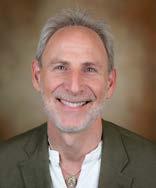
ANCIENT WISDOM 20
Hôtel Le Cep ***** France - Burgundy
Thaulle Resort **** Sri Lanka - South Coast
Neeleshwar Hermitage First Class India - Kerala
Family-run 5-star hotel in the heart of the city of Beaune. The hotel and its dedicated international team of the Ayurveda center „Holistic Center Marie de Bourgogne“ aim to offer you a relaxing break from everyday life and an unforgettable experience.

In the south of Sri Lanka, surrounded by lush nature, the Thaulle Resort awaits you directly on the shore of Lake Yoda. The sustainable use of resources and food is another part of the hotel philosophy, for which the hotel has been awarded the TourCert certificate.


Between coconut groves and beautifully blooming gardens, the resort is a place to create complete relaxation for body and mind. In the unspoiled north of Kerala and directly on the beach you can enjoy high-quality Ayurveda and wellness offers in a luxurious ambience.
included services:
› initial consultation with dosha determination

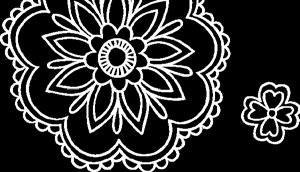
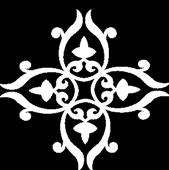
› individual treamtment and nutrition plan
› 5 treatment days with ayurvedic & int. treatments

› 3x Yoga & meditation





› 2x body or facial massage and more
4 NIGHTS incl. ayurvedic full board from $ 2,226 € 2.214
included services:
› daily yoga practice (morning & evening)
› daily meditation
› ayurvedic cooking class
› 1x temple visit
› Shuttle to Kirinda beach and more
14 NIGHTS incl. full board from $ 1,316 € 1.309
included services:
› consultations with the Ayurveda doctor


› indiv. treatment plan
› approx. 10 ayurvedic treatments per week
› daily morning Yoga in a group
› nutrition consultation, Backwater tour and more
13 NIGHTS incl. ayurvedic full board from $ 1,616 € 1.607
Consultation and booking: info@spadreams.com
Ayurveda offers at
$ 1,316 € 1.309 14 nights from
Further
www.spadreams.com/ayurveda
Ayur Yoga Retreat
Ayurveda Detox
Ayurveda Rebalancing
Further information www.spadreams.com/le-cep Further information www.spadreams.com/thaulle Further information www.spadreams.com/neeleshwar MULTIPLE AWARD-WINNING VERY GOOD 5,0/5,0 100% WOULD RECOMMEND
EVIDENCE-BASED AYURVEDA New quality standards for effective therapies
By Prof. Darshan Shankar
Ayurveda as a science of life has a long history and its basic principles are still highly modern and effective. But the climate, plants, animals and microbes have changed, as have human behavior, lifestyle and genetics. It is clear that Ayurveda can only be practiced effectively if contemporary adaptations are made. This requires continuous research into the safety, quality and efficacy of Ayurveda products and procedures. But this is easier said than done.
How is it possible to measure Ayurveda, which has its very own understanding of effectiveness and is holistically oriented, with the methods of modern medicine?

The internationally renowned Prof. Darshan Shankar, founder of the renowned TDU Bangalore, explains in this article why the modern evidence based approach (scientific proof of therapies and medicines) is timely but too one-dimensional and why we need a new contemporary, integrative approach that combines the traditional and modern understanding of efficacy, bridging the gap between science and shastra.
Verena Becker, Editorial Director
22
AYURVEDA AND MODERN MEDICINE –DIFFERENCES BETWEEN SYSTEMS OF MEDICINE
At every level of the medical system, such as principles, categories, concepts, philosophy and world view, there are major differences between Ayurveda and western medicine. Ayurveda is based on the view that "a living being is a microcosm of the macrocosm" and thus accepts the unity between the two (loka purusa samanya). On the other hand, modern science is more likely based on a dualistic worldview in which a separation between spirit and matter is made and essentially the idea is that the ultimate foundation of knowledge is based on consistent, repeatable results. Another difference is in the means of knowledge. While western science mainly relies on the logical interpretation of scientifically verifiable data, Ayurveda provides subjective insights. As far as the understanding of health and disease is concerned Ayurveda has a holistic perspective. It is based on a theory that examines the functioning of the body in relation to changes in bioenergies (doshas) and their homeostasis (balance), whereas modern medicine looks primarily at biological structures and their functions. Although this is a simplified representation of the differences between the two systems of medicine, it is obvious that Ayurveda and modern science have different theoretical foundations.
It is important to appreciate these differences and not to judge them in terms of right or wrong. They represent different perspectives and ways of recognising and looking at nature and both have universal applications. Such cultural differences should be celebrated rather than lead to conflict.
TRADITIONAL QUALITY STANDARDS: DO THEY EXIST?
It is obvious that a living, ever-evolving system of traditional medicine, which has served society for several millennia could not survive without its own quality standards. Traditional systems of medicine have their own, sophisticated internal quality standards. They include standards for the identification and collection of the plants, the processing technology, the end products, research design and therapeutic application. The criteria for the collecting of plants may include, for example, the best time of day, time of year and the best stage of growth – when the plant is most therapeutically active. They may also include the best
locations for collecting to optimise their medicinal efficacy.
INTERCULTURAL STANDARDS AS A BRIDGE BETWEEN AYURVEDA AND CONVENTIONAL MEDICINE
When one tries to compare the efficacy of one system of medicine with the criteria of effectiveness of the other, this can lead to unsatisfactory results. It is therefore necessary to develop standards that recognize and respect the differences of the disparate forms of medicine. The development of such intercultural standards is a complex task, as it requires a deep understanding of both Ayurveda and modern science. It requires the use of modern instruments of physics, chemistry and biology to create universally verifiable standards.
We have to face the following challenges:
Reliable sources: In order to identify the raw material (e.g. a plant), a reliable traditional source must be consulted. It is necessary to carefully compare the vernacular names and descriptions of corresponding botanical units. This can be a simple or complicated task. An example: tulasi (Sanskrit) is the vernacular name of a plant, which, when shown to a botanist, is associated with ocimum sanctum or ocimum tenuiflorum.
Synonyms of Ayurvedic plants: A single, traditionally used plant species can have several names with the same meaning. Therefore one has to ask for the help of traditional scholars to summarize all these vernacular synonyms. This is best exemplified by one of the important Ayurvedic texts, the Charaka Samhita. 12,000 plant names are mentioned in this work, which, after breaking down the synonymy of the names, refer to only about 620 unique plant varietals.
Standardisation of the manufacturing process and the end product: For traditional products, there is a wide range of processing techniques and dosage forms, from simple powders from a plant to extracts made from many plants. The end products may be, for example, extracts, herbal wines, herbal oils, plant starches or lyes. These different forms of administration
23
EVIDENCE-BASED AYURVEDA
were created because the end products are absorbed by the body at different rates and in different ways. This shows that concepts of pharmacodynamics (effect of medical preparations in the body) and kinetics (distribution and metabolisation in the body) have already been taken into account in Ayurveda. The standardisation of all these myriad processes and products is a real challenge for modern scientists.

Respect for traditional forms of preparation: Recently, doubts have been raised about the safety of Ayurvedic herbo-mineral preparations (bhasmas). The reason for this is the fear that such preparations cannot be absorbed and converted in the the body and could therefore cause heavy metal poisoning. Recent studies show, however that the bhasma preparation methods described in the ancient texts led to significant microstructural changes in the final product. Perhaps the ancient "chemists" were aware of the higher reactivity of very fine metal powders. The studies suggest that Ayurveda may have been the first medical science in the world to use nanotechnology in pharmacy. Note: In Europe, heavy metals in food supplements are generally not allowed regardless of whether their harmful effects have been proven or not.
Consideration of traditional contexts: In the past there have been cases where the traditional context of the use of a medicinal plant has not been taken into account, with consequences. For example, kava kava (piper methysticum) is used to make a soothing drink that is a beverage consumed by the Polynesians at festivals. This herb is promoted by pharmaceutical drug companies as an anti-anxiety drug. However, it proved to be unsafe and caused liver damage in several patients, so it had to be withdrawn. On closer examination, it became clear that the toxicity only occurs with the modern product. While the traditional preparations were water-based the modern extraction was done in acetone (solvent). Besides the socalled kava lactones, the traditional water extract also retains another compound, glutathione, which plays a role in protecting the liver. It is noticeably absent in the modern acetone extract. This glutathione in the traditional extract ensures that the side effects are reduced.
Evaluation of traditional preparations according to modern standards: This requires a new way of thinking in the design of clinical studies because Ayurveda pursues an individual and holistic therapy. This inclu -
24 EVIDENCE-BASED AYURVEDA
des dietary supplements, nutrition and non-drug therapies such as yoga. Traditional treatments aim to achieve homeostasis (balance) rather than remedy a specific factor that causes disease. These differences lead to two problems. First, study models are needed to evaluate the whole treatment package and not just a single dietery supplement. Secondly, the evaluation criteria must be in agreement with the traditional understanding of healing. However, one should not expect perfect agreement between the traditional qualitative and modern quantitative parameters, as both systems of medicine are based on different principles, categories and concepts. Western medicine assumes a one-to-one relationship between cause and effect and therefore orthodox medicines are generally aimed at alleviating only the assumed cause. In Ayurvedic pharmacology, the entire holistic and far-reaching effect of nutritional supplements is applied to several seemingly unrelated aspects of the organism.
FUTURE GOALS

New scientific methods and appropriate criteria must be developed and researched to evaluate the various pharmacologically active preparations of Ayurveda. Due to inadequate investment, consumers all over the world are deprived of the benefits of safe and effective traditional food supplements or cosmetic products. Policy makers and researchers should understand that authentic modern standards for Ayurvedic products and therapies can only be established through intercultural and integrative research. This is important because this can enrich the field of medical pluralism – which is key to the progress of world medicine.
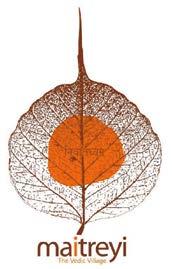
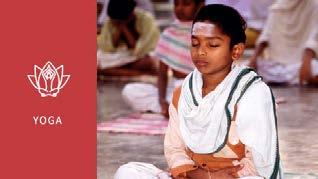
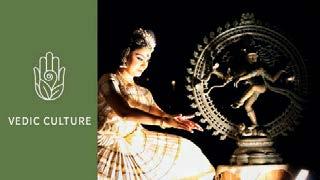
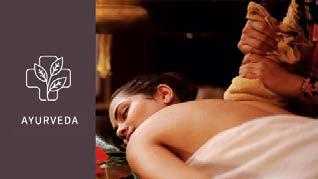

Prof. Darshan Shankar
is the founder and Vice-Chancellor of the Trans-Disciplinary University (TDU) in Bangalore. TDU conducts advanced research in the field of Ayurvedic biology. A new transdisciplinary field that brings together the systemic perspectives of Ayurveda with the molecular approaches of biology. His work has been been awarded various national and international prizes. www.tdu.edu.in
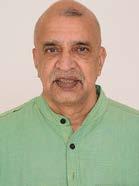
The vedic village Ayurveda Treatment Vedic Culture Yoga & Meditation Balance your Body, Mind and Spirit in our holistic Vedic Center. www.maitreyivedic.in Join our Ayurveda Retreats
25 EVIDENCE-BASED AYURVEDA
Between science and spirituality
Is Ayurveda spiritual?
As a scientist who researches the efficacy of Ayurvedic medicine in Sri Lanka and at the same time practices yoga and meditation, I am often asked these questions. "Isn't Ayurveda spiritual?
And aren't science and spirituality mutually exclusive?" This article explains why spirituality plays a major role in Ayurveda, what is meant by it and how medical science can benefit from a spiritual framework of thought.
 By Verena Becker
By Verena Becker
26
t first glance, science and spirituality do not have much in common. So it is quite understandable that many people assume that one cannot be reconciled with the other. But before we make a judgement about what Ayurveda is and what it is not, we should question why we think science is the measure of all things and what spirituality means to us.
READING SCIENTIFIC STUDIES CORRECTLY
To know whether these studies actually deliver what they promise, you have to read between the lines of the study and interpret the study designs and results correctly. "I only believe the statistics that I faked myself" is also a popular saying because small manipulations that make the results appear as significant as possible are absolutely common and legitimate. Scientific studies are therefore not the measure of all things. They can provide important insights but they also have their limits.
LIFE CANNOT BE TESTED IN A TEST TUBE
Ayurvedic therapies are extremely complex and may involve recommendations to lifestyle changes, taking nutritional supplements and, for example, yoga exercises. How should we measure this complexity? Either it is possible to reduce the complexity and, for example, evaluate only one dietary supplement or we get the Ayurvedic holistic and individual approach, which then leads to a lower study quality. The need for scientific evidence of Ayurveda is not necessarily the problem but rather the kind of evidence that is demanded. Ayurveda translated means the "knowledge of life" and life does not happen in a standardised way and cannot be tested in a test tube. It is multifaceted, complex and always changing.
WHAT SPIRITUALITY MEANS IN AYURVEDA
Since it is our aim that Ayurveda is perceived as a form of medicine in Germany and wordwide, it might be helpful to question what spirituality in Ayurveda means and what it does not mean.
The Latin word "spiritus" can be translated as "spirit" or "breath". The word "spiritualitas" can be translated as "spirituality". Spirituality can therefore be understood in

new pukkaherbs.com awaken your senses with our new tea 27 SPIRITUALITY
A
a broad sense as any form of spirituality in contrast to materiality and physicality. It is thus an inner and subjective quality of us and a state of our consciousness that influences the way we think and act.
Like a kind of inner compass, it can direct and guide us to something – for example, the will to know and learn something or the will to behave and interact with our environment in a certain way.

Therefore, spirituality in Ayurveda is also understood as a quest for self-knowledge and an ethical guideline. It is a natural part of being human and belongs to all of us. Self-knowledge means that we question our own thoughts and actions again and again to know ourselves better everyday. Because it is only when we understand our very nature that we are able to make beneficial decisions for our lives that do us good and strengthen us. At the same time, avoid those things that weaken us. However, this can be very different from person to person. For this reason, Ayurveda's diagnostic and therapeutic approach is characterised by strong individuality. Each of us has a unique physical (vata, pitta, kapha) and mental constitution (sattva, rajas, tamas) and therefore also unique needs. Thus spirituality also needs an individual approach that is adapted to modern living conditions, age, profession or way of life and constitution.
Furthermore, a certain degree of self-knowledge and reflectiveness also leads us to be honest with ourselves and, in the best case, to others. So we start by aligning our thinking with ethical standards and acting accordingly. A modern understanding of spirituality thus encompasses practical, cognitive and meaningful elements. Spirituality is the search for truth and for that, you don't need incense sticks or
Vedic mantras. Modern spirituality does not need esoteric practices, world views or any religious affiliation. Apart from this, many religions hardly correspond to the Ayurvedic understanding of spirituality. Spirituality in Ayurveda may therefore be completely secular – unattached and free from any dogmatism.
SCIENCE AND SPIRITUALITY - TWO PATHS TO KNOWLEDGE
Science and spirituality are two paths to the great insights of the world. Even if these two approaches have many differences, there are also some commonalities. While the modern medical sciences are based on objectivity, spirituality is more about inner processes – the subjective. What unites both, however, is the indispensable search for truth. Both are interested in their perspective in their own different ways. The persuit is to find the knowledge to simplify people's lives and thus reduce suffering. Therefore, both approaches have similar ethical guidelines.
THE MEANINGFUL UNION OF SCIENCE AND SPIRITUALITY
As different as the two approaches may seem at first glance – in practice they can complement each other perfectly in their search for truth. Spirituality can serve science in its ethical orientation, by its nature of looking at the "gross and whole" and its questions about meaning and value. It gives science an ethical and meaningful framework, which enlightens us on what really matters in science. For example, to focus more on making people's lives easier and making a lasting effect than finding "good evidence". This way the rigid demarcations between science and spirituality dissolves both objectivity and subjectivity. Thereby these seemingly opposing poles merge naturally with each other.

28 SPIRITUALITY

AMLA Natur Vertriebs GmbH Butterberg 3 | 21279 Drestedt | Germany Tel. +49 (0) 4186-887 99-0 Fax +49 (0) 4186-887 99-21 service@amla.de www.ayurveda-marketplace.com Ayurveda products organic • natural • produced in-house • clean & safe AMLA Natur GmbH - leaders in production, import and distribution of authentic ayurvedic products in Germany for nearly 25 years. WE LOVE AYURVEDA ADVERT
Product Range & Quality Standards
Under our brand Classic Ayurveda, Amla Natur offers widely varied, Ayurvedic products. All our products comply with Ayurvedic standards by following the principles of quality and authenticity.
Our product range includes organic Ayurvedic foods and spices, food supplements, massage oils and natural cosmetic products. Besides traditional Ayurvedic products, we also offer innovative and modern products such as ready-to-cook dishes.
Amla Natur GmbH is the standard setter for the safety and quality of Ayurvedic products. Our quality management is unique in Europe. From the raw material checks to the final control, every product is subject to a multilevel control system. Our team of experts on Ayurveda plants and pharmacology visit growers and manufacturing facilities in India to choose the best quality organic products.
We assure transparency of the manufacturing processes by having a local presence. Before being exported to Germany, all goods are checked for purity and freshness. Each batch is checked by an accredited laboratory for harmful substances (heavy metals, microbiological contamination, mycotoxins, pesticides, ETO).

Private Label

AMLA Natur Vertriebs GmbH • Chief executives: Buko Hartmann, Steffen Werner • District court Tostedt: HRB 4209 • DE-ÖKO-037 Online Shop: www.ayurveda-marketplace.com • Retailers: retailer.ayurveda-marketplace.com Factory
you like to sell products under your own label? We offer a wide range of private label products for our international business customers. Contact us: hartmann@amla.com
Would
Buko Hartmann
Distributor wanted Contact us now ADVERT Amla Natur GmbH
Ayurvedic Foods
Everything you need for a healthy and delicious Ayurvedic diet.
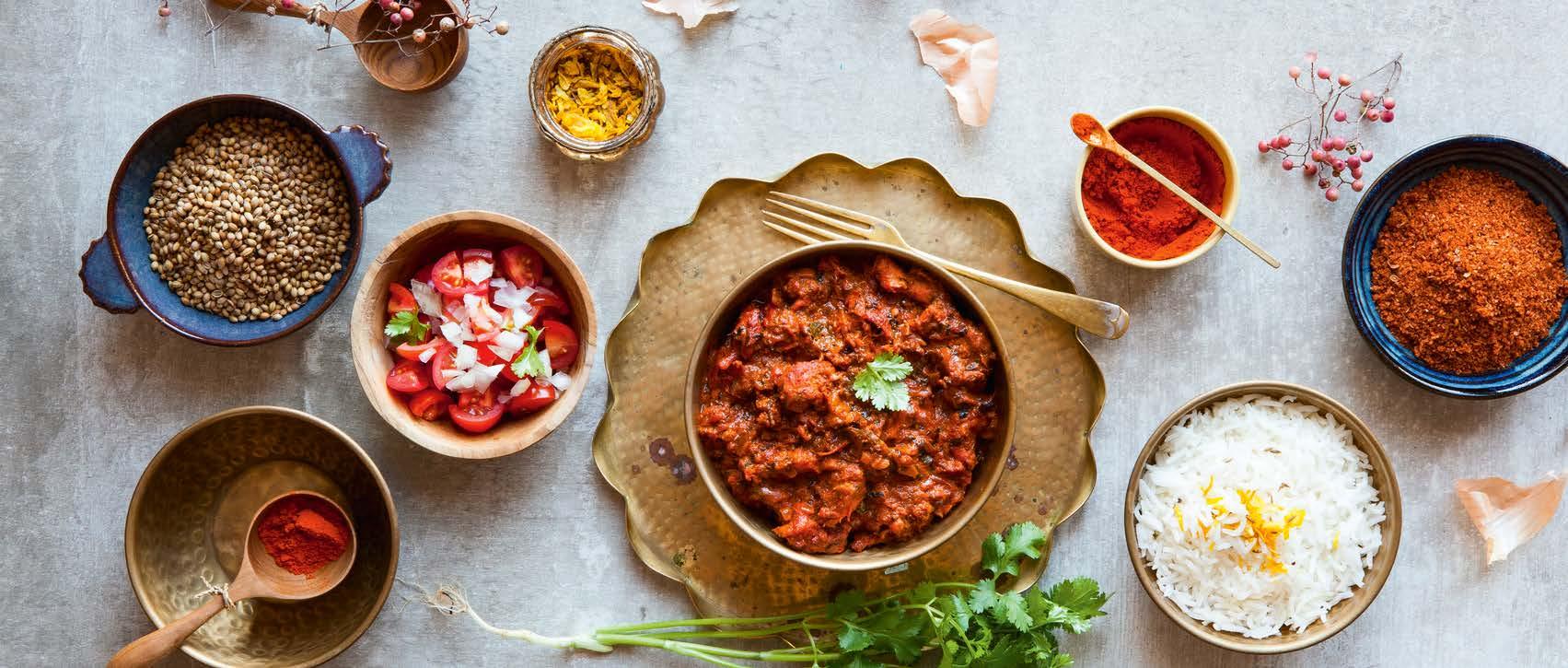
We offer a wide range of natural products, mostly organic, for Ayurvedic and Indian cooking. Our range includes:
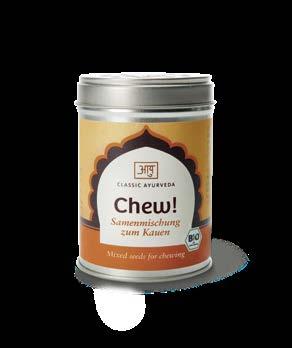
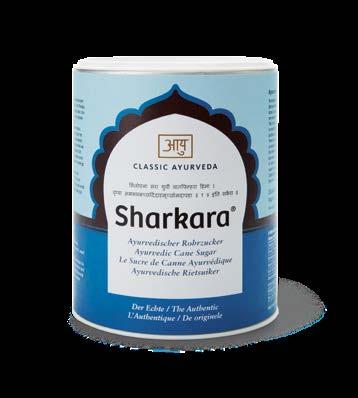
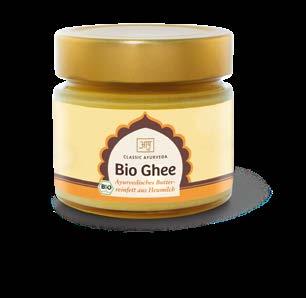
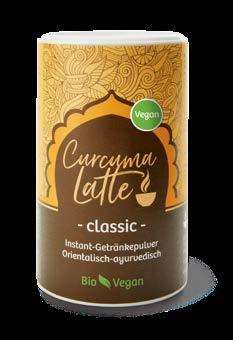
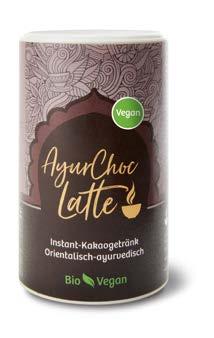
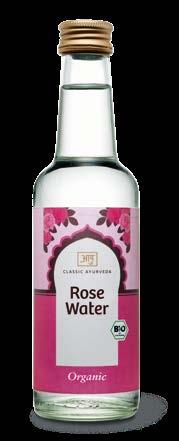

• Products made of amla fruits
• Ayurvedic and Indian staples such as basmati rice, various types of dahl, ghee, vegetable oils and fats, rock salt, Ayurvedic sugar
• Innovative products such as convenient mixes for ready-to-cook products, snacks and sweets
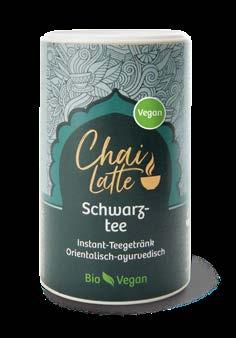
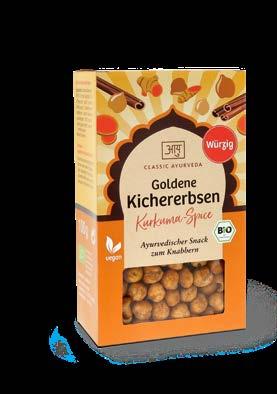
• Easy to use dosha balancing products
Shop here: www.ayurveda-marketplace.com
Retailers: retailer.ayurveda-marketplace.com
Delivery to all countries of the European Union (EU)
ADVERT
Classic Ayurveda Products
Quick Cook Ayurveda
Innovative Ayurveda products for a modern lifestyle.
Perfect when you want it to be quick, tasty and healthy.
• Ayurvedic recipes
• 100 % natural ingredients
• No flavourings or preservatives
• No added sugar
• Made with love in our facility
Classic Ayurveda Naan Baking Mixes, organic For Indian Flatbread
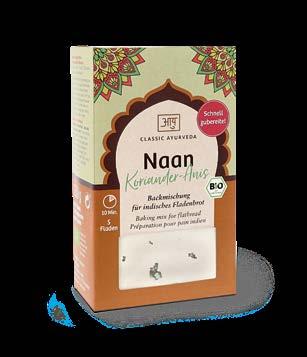
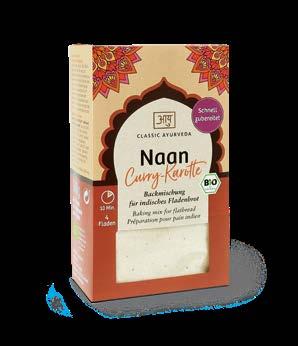
• Quick and easy to prepare in the frying pan
• Ready in only 10 minutes
• Ayurvedic recipe without yeast
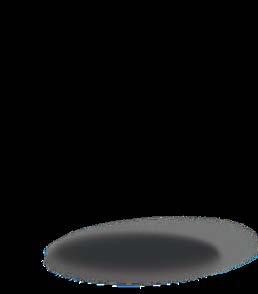
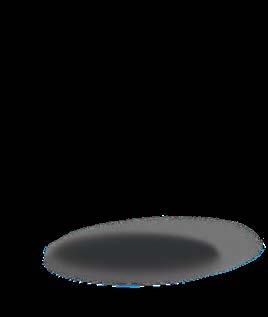

• Refined with spices and vegetables
• Eco-friendly packaging
Classic Ayurveda Kitcharis, organic Ayurvedic dish made from mung beans & basmati rice
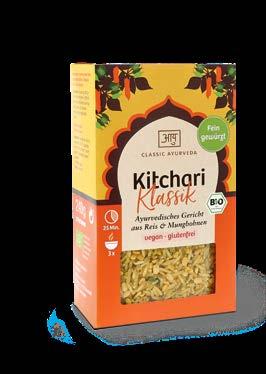
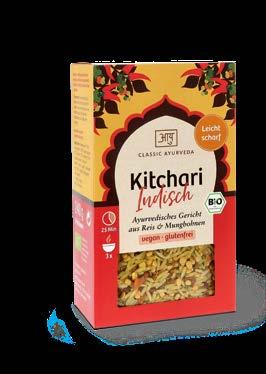
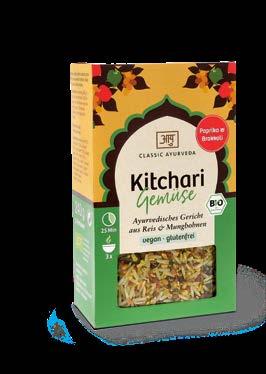
• The ideal Ayurvedic lunch or light dinner
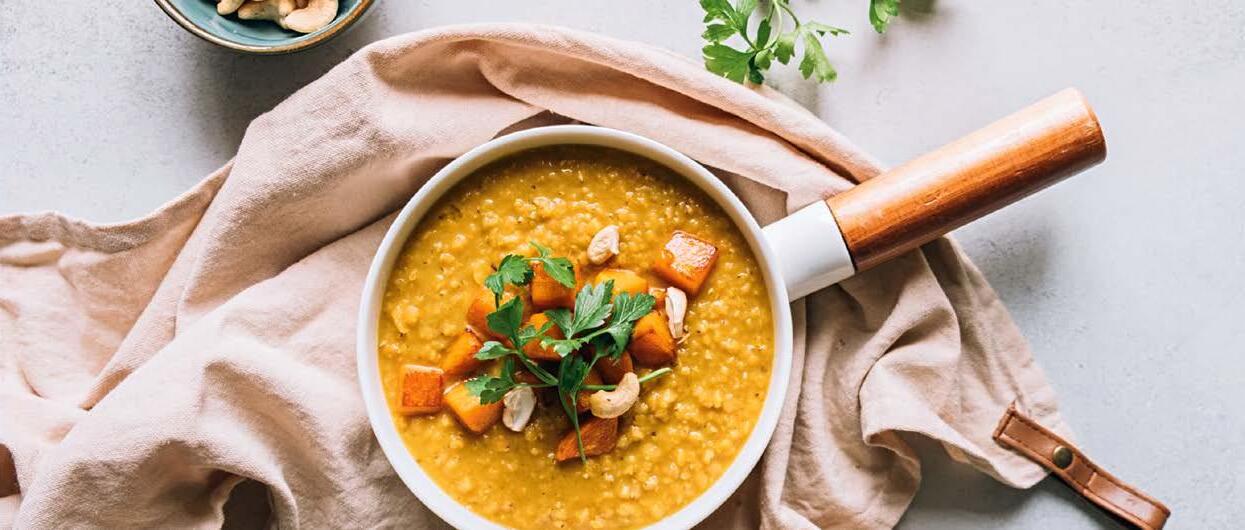
• Quick and easy to prepare, ready in 25 minutes
• Deliciously spiced Ayurvedic recipe
• Gluten-free and vegan
Classic Ayurveda Porridges, organic
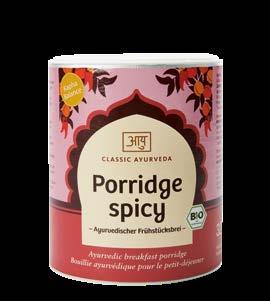
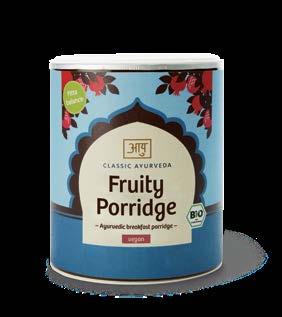
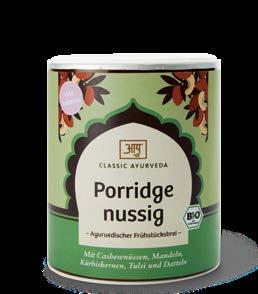
• Ayurvedic recipes with nuts, fruits and spices
• Quick and easy to prepare
• Three delicious varieties for vata, pitta & kapha
Shop here: www.ayurveda-marketplace.com
Retailers: retailer.ayurveda-marketplace.com
Delivery to all countries of the European Union (EU)
Classic Ayurveda Products
Ayurvedic SpicesSingle, Mixed, Toppings
Easily made Ayurvedic cooking
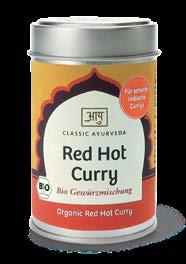
Is Ayurvedic seasoning complicated? Not with the right spice blends. We have developed high-quality organic blends for every type of food and dosha type, that taste delicious and make Ayurvedic cooking easier for you.
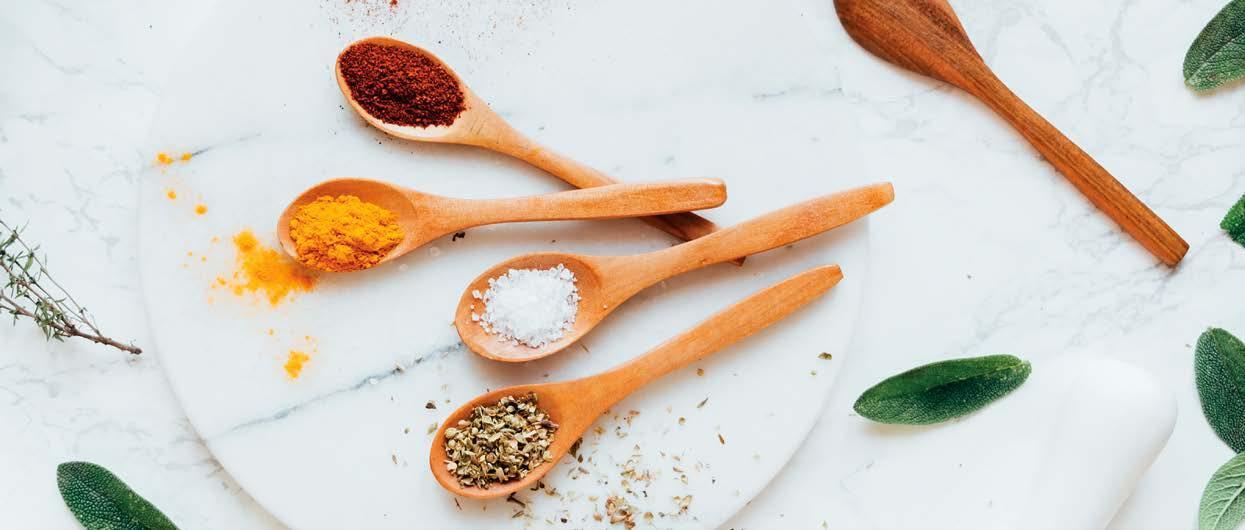
Classic Ayurveda Spices:
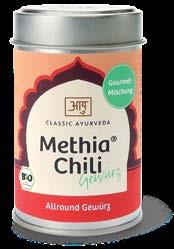
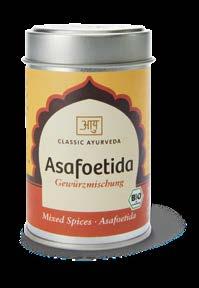
• For Ayurvedic and Indian cuisine
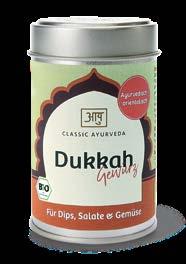
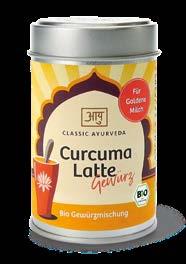
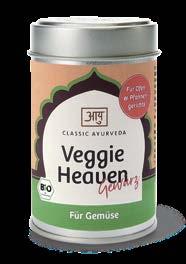
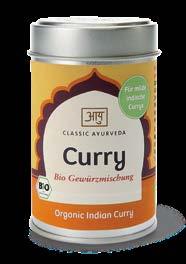
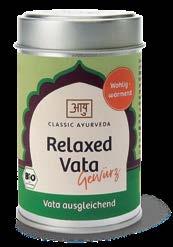
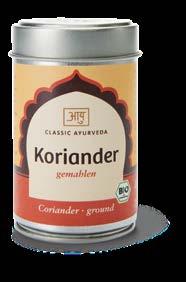
• Delicious Ayurvedic recipes
• From the best organic spices
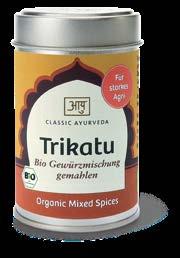
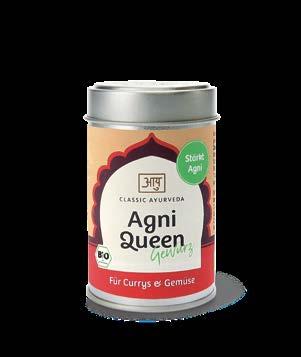
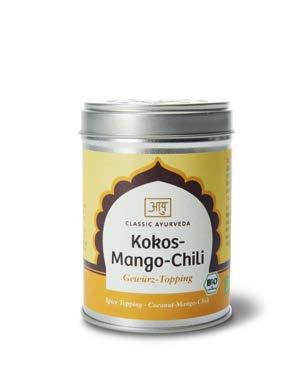

• Made with love in our facility
• Environmentally friendly packaging
• Recyclable tin can
Shop here: www.ayurveda-marketplace.com
Retailers: retailer.ayurveda-marketplace.com

Classic Ayurveda Products ADVERT
Delivery to all countries of the European Union (EU)
Certified
Natural Cosmetic

Classic Ayurveda Cosmetics – made from valued natural ingredients based on Ayurveda’s ancient knowledge. Suitable for every type of skin. BDIH-certified or COSMOS quality.

• Facial care
• Body care
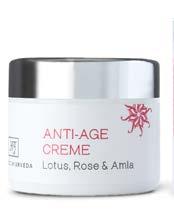
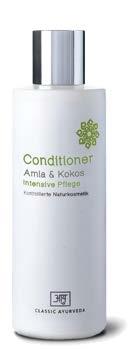
• Massage
• Facial cleansing
• Hair care
• Oral care
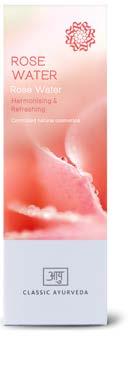

Shop here: www.ayurveda-marketplace.com
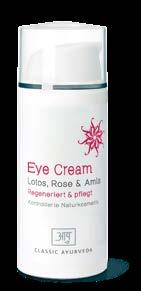
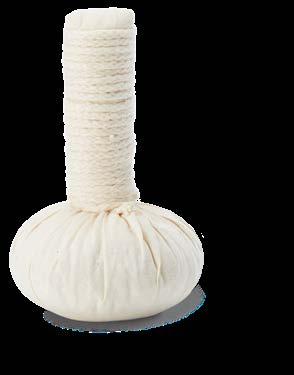

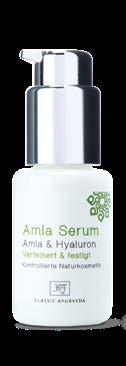

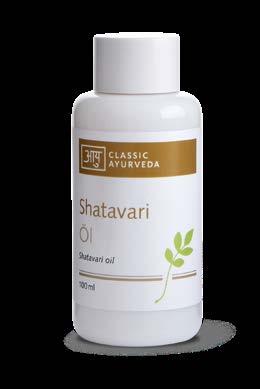
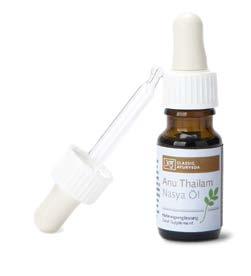
Retailers: retailer.ayurveda-marketplace.com
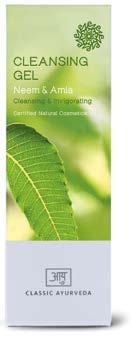
Delivery to all countries of the European Union (EU) Classic Ayurveda Products ADVERT 34
Ayurvedic Food Supplements
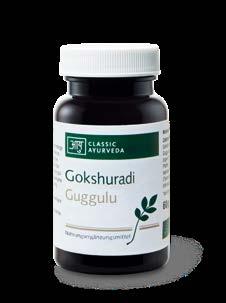
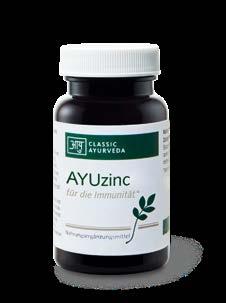
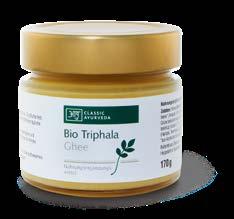
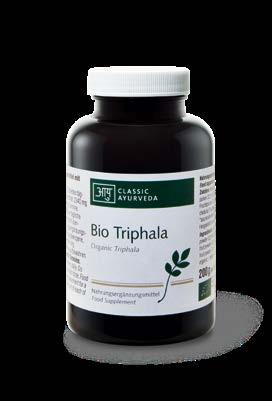

We provide a wide range of organic herbs for a balanced life. We choose our growers and manufacturing facilities in India carefully. Amla Natur GmbH has been importing Ayurveda herbs from India for 25 years. A specialised knowledge of the cultivation of Ayurveda herbs in India has been developed by our experts over two decades. We offer safe, lab tested, high quality raw materials. Our herbs are tested for their plant compounds content (phytochemicals) and for impurities (microbiology, mycotoxins, pesticides and heavy metals).
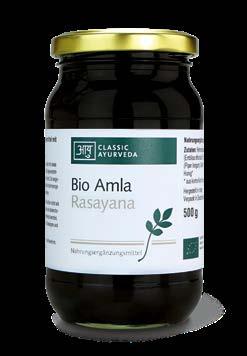
Our products:
• Churnas (single churnas & mixed churnas)
• Tablets and capsules
• Guggulus
• Arishtas & asavas
Shop here: www.ayurveda-marketplace.com
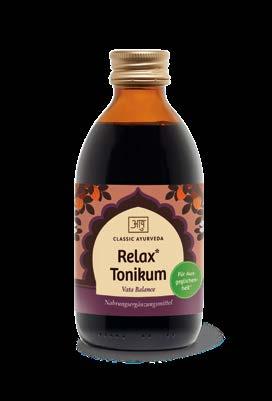
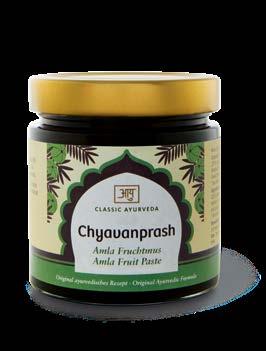

Retailers: retailer.ayurveda-marketplace.com
• Herbal extracts
• Chyavanprash
• Ghritas
• Rasayana
Classic Ayurveda Products ADVERT
Delivery to all countries of the European Union (EU) 35
Learning Ayurveda through the pulse
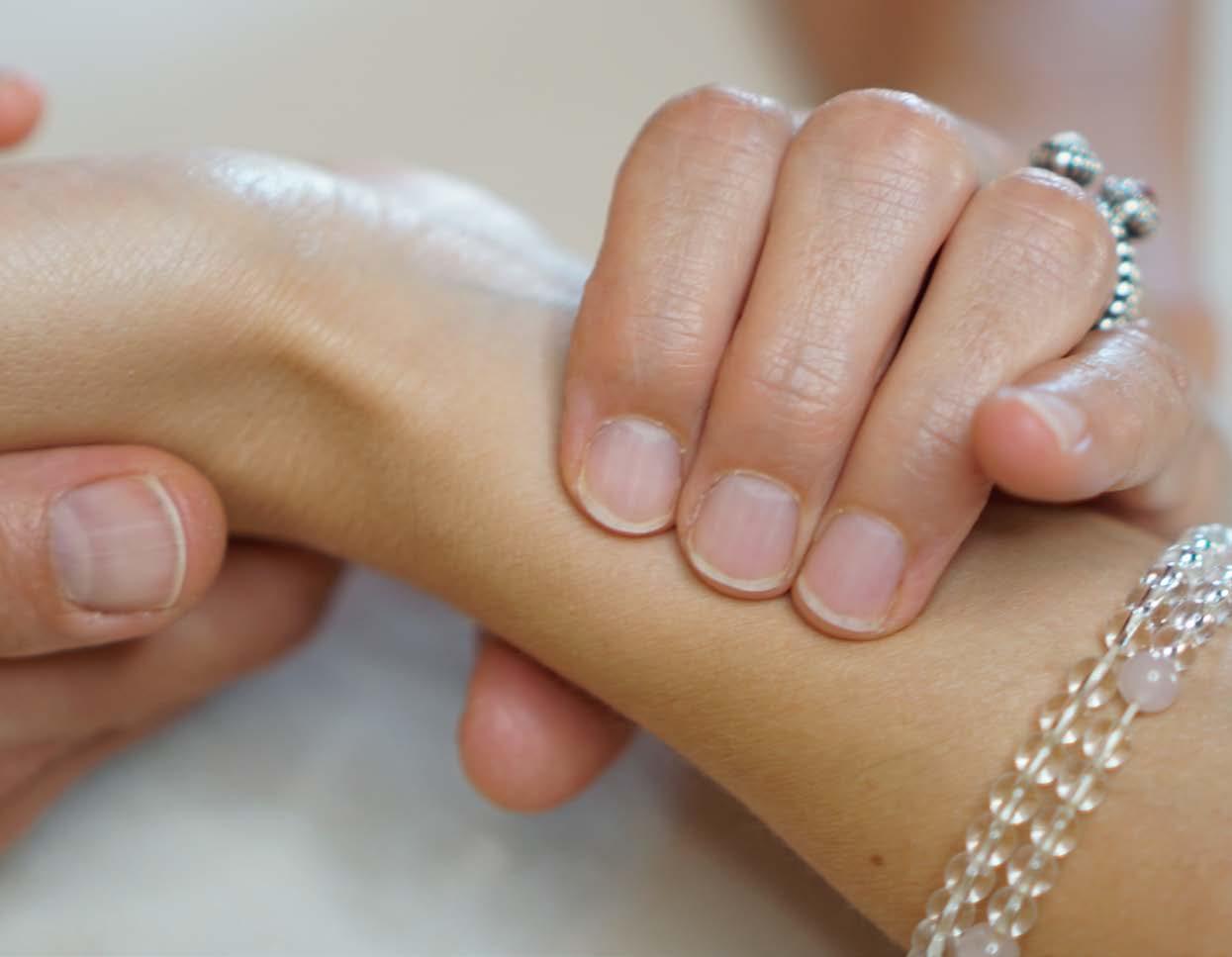
Nadi vigyan - the Ayurvedic pulse diagnosis
By Dr. med. Ernst Schrott
„In the pulse we feel the vibration of the cells, tissues and organs, every delicate expression of consciousness, the melody of individual life.“
Vaidya J. R. Raju, Hyderabad
Nadi vigyan, the art of reading the pulse, is an extraordinary diagnostic method. It enables us to feel the entire spectrum of Ayurvedic principles and concepts in the pulse of the patient and thus to grasp them in the true sense of the word. In the pul-
se we feel the pulsation of life itself, the vibrations of health or sickness, the constitution of the patient, his readiness to react to the environment and treatments, the metabolism of the body tissues (dhatus), unprocessed emotions and stressful life events, the accumulation of toxins, etc. – thus the key disturbance(s) that cause the patient's illness. Ayurvedic pulse diagnosis also allows us to recognise a disease before it manifests. It is therefore a valuable diagnostic tool for prevention and early detection.
36 PULSE DIAGNOSIS
ALREADY USED FOR THOUSANDS OF YEARS
The first reference to the use of a medical pulse diagnosis is found in the oldest comprehensive work of Ayurvedic medicine, the CharakaSamhita (ca. 8th century BC). In a short verse it refers to the importance of feeling the pulse: "Life, when perceived by tactile diagnosis, is present in the heart. There is the seat of the highest oja and the essence of consciousness". A more concrete statement of the significance of the pulse is found in the Sharngadhara Samhita, a much younger collection of scriptures (13th century AD). Here it says: "The pulsation of the artery at the base of the thumb (wrist) is an expression of life. Happiness and sorrow, health and illness, should be recognised by the doctor from its vibrations".
PASSED ON IN FAMILY TRADITIONS
Pulse diagnosis has a very long tradition in Ayurvedic medicine. However, until a few years ago only a few mastered it. At the Ayurvedic universities and colleges in India, it is no longer taught. Other branches of knowledge and therapeutic approaches have also been suppressed by various causes, such as the suppression of Ayurvedic medicine by conquerors and through loss over time. Yet, some of the knowledge that has passed down through family traditions is still applied.
As part of a comprehensive initiative to renew and revitalise Ayurveda in the early 1980s, through the initiative of the Vedic scholar Maharishi Mahesh Yogi, pulse diagnosis was also included as part of the training for doctors and alternative practitioners.
MASTER OF PULSE READING
The art of reading the pulse is interpreted completely differently by two outstanding masters of Ayurvedic pulse diagnosis.
PULSE DIAGNOSIS THROUGH LEARNING PULSE PATTERNS
Dr. Dev Triguna, former President of the All India Congress, the largest Ayurvedic medical organisation in India, was famous for his precise diagnoses, even in the western sense. Dr. Triguna had his practice in Delhi and treated up to four hundred patients daily. He based his diagnosis and therapy almost exclusively on the pulse of the patients. I was allowed to meet him for the first time in Croatia. In the hotel where his consultations took place, hundreds of people were waiting. The patients had been pre-examined by western doctors including myself. We noted down their medical histories and diagnoses and took them to Dr. Triguna's treatment room but he wasn't interested nor did he question the patient. He first took the pulse and then made his own diagnosis.
I remember situations like this well: a young man, looking completely healthy, had diabetes. Externally, there was not the slightest indication of the disease. Dr Triguna took his pulse for five seconds and then literally said, "This man has diabetes!" A young woman had been suffering from headaches for years. She had previously described her complaints to me in detail.
ayurveda-rhyner.com

• 100% organic massage oils with European herbs
• 100% organic spices & herbal infusions

• Ayurveda Clinics in Europe
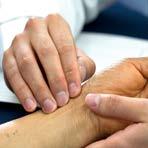

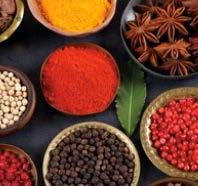
• Certified classical Ayurveda Oils
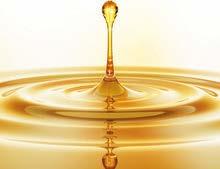
• Supplier of equipments & raw materials
• Products of our new Brand „HappyVeda“ ayurveda-rhyner.in

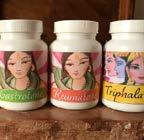
AYURVEDA RHYNER® Since 40 years AYURVEDA RHYNER® Austria • Switzerland • India 37 PULSE DIAGNOSIS
The pains were pulsating, always started on the right side of the neck, then went over the top of the head to the forehead and up to the right eye. Dr. Triguna briefly felt the pulse and described the woman's complaints almost in the same way the woman had described: "This lady has pulsating pain, it starts on the right side of the back of the neck, continues along the top of the head, the right forehead and ends in the right eye".

He was asked how he acquired this ability and what it was based on. He explained his method with an example: during an epidemic of viral hepatitis in Delhi he had taken the pulse of thousands of people. Afterwards he knew the characteristic pulse pattern of this disease and was able to make a reliable diagnosis.
His method was therefore based on experience and learning and recognising certain vibration patterns in the pulse. Dr. Triguna's method could only be taught to a limited extent. It was his own personally acquired ability to read the pulse.


PULSE DIAGNOSIS BASED ON A DEFINED SYSTEM
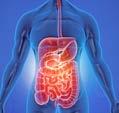


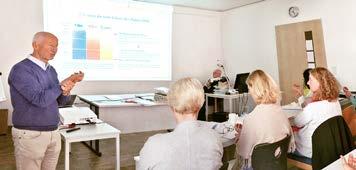
The second outstanding vaidya and master of pulse diagnosis was and still is Dr. J. R. Raju from Hyderabad in South India, who comes from a highly respected vaidya tradition.
Over four decades he has trained thousands of western doctors and alternative practitioners in pulse diagnosis. Learning Ayurvedic pulse diagnosis has become a core element of training in Maharishi Ayurveda.
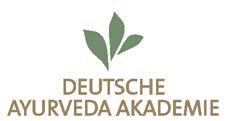
He had been taught the system of pulse reading by his grandfather from an early age. Dr. Raju's method is based on a defined system – quite different from that of Dr. Triguna. It is teachable and learnable. All Ayurvedic principles – the physical-spiritual regulating principles (doshas) and their sub-functions (subdoshas), the metabolic activity of the seven body tissues (dhatus), the digestive fire agni, the finest essence of complete digestion (ojas), the body channels (srotas), the accumulation of digestive toxins (ama) etc. – can be detected as characteristic frequency patterns and pulsations at defined points on the three fingers that feel the pulse and at different pulse levels.

PULSE DIAGNOSIS
This system is therefore teachable, learnable and reproducible. Anyone who feels the pulse of a patient in this way arrives at the same result. He feels the different Ayurvedic principles at the typical places in comparable strength and as a similar pattern. He arrives at the same diagnosis through the synthesis of all the information that leads to the same diagnosis.
WHY THE AYURVEDIC PULSE CAN ONLY BE MEASURED USING THE TRADITIONAL METHODS
According to the ancient Vedic texts, Ayurveda and other Vedic branches of knowledge have been subjective knowledge obtained by introspection. Ayurveda is, according to its own understanding, a subjective science. The "measuring device" is consciousness, the subjective ability of the doctor to perceive holistically through his senses. Modern medicine, on the other hand, bases its diagnoses and therapies on objective findings and therefore also prefers to use apparatus based methods. The subjective is a perception that appears to be individual and therefore not fundamentally reliable.
Today, in a globalized world, east and west meet the philosophical systems of the ancient world and the scientific way of thinking of our time. Experience shows both systems can complement each other. While Ayurvedic medicine treats synthetically and views holistically, modern medicine takes an analytical approach that investigates the detail. Feeling the pulse of the patient is a bridge between the two systems. For example, if the doctor feels a gallstone in the pulse, he can use an ultrasound scanner to visualize it.
PULSE DIAGNOSIS IN EVERYDAY PRACTICE
In daily practice, Ayurvedic pulse diagnosis is an indispensable diagnostic tool. An x-ray or an MRI are static, they may show changes in body structures that are important but they do not show the vibrations of a sick person sitting in front of you. That is fundamentally differentiating. In Ayurvedic medicine, we treat the whole person and not just the disease. Above all, the doctor feels the whole person with all the vibrations of cells, tissues and organs, his health and his illness. Feeling the pulse is a trustful encounter between the doctor and the patient, who feels understood in that moment. It is not uncommon for tears to come, especially when a psycho-emotional event, a deep-seated sorrow is felt in the pulse.
LEARNING AYURVEDA THROUGH THE PULSE
At the German Ayurveda Academy we teach Ayurveda and its mind-body model exclusively on the basis of the pulse. As already mentioned we grasp what we feel in the pulse. One can understand vata, pitta and kapha intellectually, but felt in the pulse we experience this triad directly: the cheerful lightness of Vata, the warm pulsation of Pitta and the tranquil flow of Kapha. This applies all the more to the specific functions of the three regulating principles, the so-called subdoshas. For example, as mental energy and activity in the nervous system increases, prana-vata feels quite characteristic and high-frequency. That is quite different from apana-vata, the excretory principle, or sama-vata, which provides movement and transport in the gastrointestinal tract.
SELF-PULSE FEELING AS A THERAPY
The most important Ayurvedic principles can also be felt by lay people in their own pulse. I am surprised by how well this works and how accurately even the non-medical practitioner can read the pulse. At the same time, feeling one's own pulse is an effective method of supporting self-healing. As in meditation, feeling one's own pulse directs one's attention inwards, to finer, subtler areas of physiology and consciousness, often to the point of experiencing inner stillness. Through this self-reference we come into contact with the organising and controlling intelligence that underlies the organism. In the pulse we feel consciousness in its most delicate vibrations to its most concrete forms of expression, the entire spectrum of an individual life.
Ernst Schrott, MD
has practised naturopathy in Regensburg from 1984 until 2021. He is known throughout Europe for his publications and bestsellers on Ayurveda and Vedic technologies of consciousness and his extensive lecturing and and teaching activities at home and abroad. Dr. Schrott was co-founder and vice-president of the German Society of Ayurveda and director of the German Ayurveda Academy.
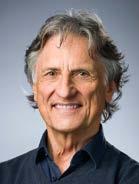
39 PULSE DIAGNOSIS
MehndiThe magical art of henna painting
By Petra Rascher
Mehndi is the most common term for body painting with henna and is derived from the Sanskrit word mendhika, which means "what gives colour". It is pronounced mehndi, mehendi or mehandi in the Indian language and also means henna plant in Hindi.
EXPRESSION OF GRACE AND BEAUTY
For thousands of years, mehndis have not only been an expression of grace and beauty but also a special form of jewellery for ritual festivities and spiritual occasions. In many cultures, colours play an important role in religious rituals and fertility cults. They represent the connection to the cycle of nature and the universal trinity of man, earth and cosmos. The colours red or reddish brown, which
are inherent in henna painting, symbolise exclusively positive qualities such as beauty, fertility, love and health.

HISTORY
The origins of the use of the henna plant go back to ancient Egypt. On 5,000-year-old mummies, dyed finger and toe nails as well as hair dyed with henna were found. Gradually, the plant spread across North Africa, the Near East and India to Southeast Asia. The motifs typical of each country can be found in carpets, carvings, textiles, fabrics, wall hangings and architecture. Flowers symbolise feminine beauty, the lotus signifies purity and is considered the cradle of the universe and the seat of the god Brahma, birds are considered mediators between heaven and earth, fish stand for
ART OF HENNA 40
fertility, as do droplets and dots. Circles are associated with the sun and with it warmth, light and new beginnings.

Over the centuries, body decoration with henna developed into a highly respected art and the ornaments used became more and more detailed. In ancient Indian images, one sees Hindu deities whose hands and feet were decorated with mehndi. Most Indian women, however, associate mehndi with the goddess Lakshmi, who stands for beauty and abundance.
MEHNDI AT WEDDING CEREMONIES
Throughout the Orient, the Near East and India, a wedding ceremony is always accompanied by a mehndi painting, which takes place on the so-called henna night about two to three days before the wedding.
All the women of both families come together and after they have thoroughly cleansed themselves, the mehndi master, a nagassah, is called and all the ladies present are painted by her. The bride, however, gets the most beautiful and elaborate henna painting, with not only hands and feet but also the forearms and calves up to the knees being decorated. These are the only visible parts of the body under the voluminous wedding dresses anyway.
The colour intensity of the mehndi has great significance in Indian folk belief: it is believed that the darker a mehndi becomes, the more fertile, healthy and long-lived the bride will be. Those who develop a dark red mehndi have hot blood and are healthy. In addition, the mehndi is said to be auspicious and to protect against mischief. Ultimately, this ritual is an important initiation rite in which the girl becomes a woman.
ART OF HENNA Ayurvedathe science of a healthy and happy life Engel Ayurveda & Detox Dolomites - South Tyrol www.ayurveda-dolomites.com 41
THE HENNA PLANT
Lawsonia inermis is the botanical name for the henna shrub, which belongs to the loosestrife family and grows about two to four metres tall. The shrub bears small, sweet-smelling, cream to pink or red flowers from which a beguiling perfume can be made.
The henna plant is harvested from large fields twice a year and only grows in hot, dry areas. For the henna used in henna painting, only the very young shoots of the shrub with red blossoms are used, because these contain the most chlorophyll.
For the production of colourless henna, which is used in the production of sunblocks, face masks, creams, lotions and shampoos, the leaves of the white flowering henna bush as well as older shoots and leaves are needed.
AYURVEDIC QUALITIES OF HENNA
In Ayurveda, henna is considered a cooling skin therapeutic agent and is only used externally for cosmetic purposes. Basically, the plant has astringent and bitter properties. Because of these, henna has a cooling effect on the skin and the paste has always been applied to the palms of the hands and feet to drive the heat out of the body in high temperatures.
Henna is also known as a hair dye and, when used as a colourless hair treatment, for its balancing effect on the scalp. It is attributed with hair-building and nourishing qualities.

CARE OF THE BODY PAINT
Allergic reactions rarely occur with natural, pure henna. After removing the dried paste, it is best to care for your henna painting with sesame or eucalyptus oil so that it appears as intense as possible and lasts for a long time. However, since the skin continuously renews itself every day, henna never lasts longer than one to two weeks and then disappears without leaving any residue.
Mehndi is a unique, enchanting art form and celebrates the beauty of the body in a meditative, creative way, touches the soul and gives the wearer mystical sensuality and exotic femininity.
Petra Rascher studied art, is a make-up artist, tattooist, body painter, book author and alternative practitioner. After her return from the USA, where henna art has been practised since the nineties, she deepened her knowledge on numerous journeys through India, Asia and the Orient. Henna painting and body art products are available in Hamburg at her Mehndi Temple. www.mehnditemple.com
42
ART OF HENNA
INDIAN FRANKINCENSE

Interview with the pharmacologist Prof. Dr. Hermann Philipp Theodor Ammon about the versatility of Indian frankincense and the underestimated potential of the millennia-old medicinal plant.
Professor Ammon, how did you actually get the idea to look into the effects of frankincense?
My colleagues and I had been sent a medicine called "saleil guggal" from India – with the request that we look into it. We had no idea what "saleil guggal" was. We were asked to find out if there was actually anything pharmacologically to this drug. We then did experiments on isolated cells that are
capable of producing substances that cause inflammation in the human body. And to our surprise, we found that this drug from India actually seemed to work. We separated boswellic acids from the resin and used them again in our tests – with positive results.
What did most doctors say about it at first?
For a long time I was laughed at. They said "Frankincense? You must be crazy". That belongs in the church. But in the meantime, millions are being made from incense products. And the trend is rising. But unfortunately there is still no approved medicine in Germany.
43
INTERVIEW
Olibanum, the resin of the frankincense tree, has been used as a remedy for thousands of years. Why do we nevertheless usually only associate the plant with incense on spiritual occasions?
It had simply fallen into oblivion as a remedy in the West. Olibanum was part of the German pharmacopoeia until the middle of the 20th century and was prescribed by doctors. In 1938, Gerhard Madaus' "Lehrbuch der Biologischen Heilmittel" (Textbook of Biological Remedies) still mentioned internal uses, including for hoarseness, gout, rheumatism, bladder and kidney ailments. Olibanum was used externally in the form of ointments and plasters, for example for boils. However, due to the rapid development of synthetic chemical substances and the advance of "evidence-based medicine", olibanum had no chance, as there was no scientific data available for this resin.
What has Ayurveda been using Indian frankincense for, for thousands of years?
According to the ancient definition, frankincense is used for diseases that are associated with an excess of pitta, with too much fire. So essentially for inflammatory diseases. Indian frankincense helps, for example, with diseases of the nervous system, intestinal diseases, coughs, hoarseness, colds.
In ancient times, olibanum was also used by doctors such as Hippocrates or Galen for diseases of the musculoskeletal system, the gastrointestinal tract, the respiratory tract, the skin, the reproductive organs and even for tumours.
These applications were also found in the Middle Ages up to modern times.
What makes frankincense so valuable?
The ingredients of frankincense, the boswellic acids, have an antiinflammatory effect. They inhibit the activity of the enzyme 5-lipoxygenase, a key enzyme in inflammation.
Today, there are more than 250 publications dealing with chemical analysis of the ingredients of olibanum, investigating mechanisms of anti-inflammation but also the effect on factors of the immune system as well as on various tumour cells. The boswellic acids present in frankincense push back water accumulations that form around a tumour. This can then be better treated surgically.
Is boswellia already used in Germany?
In Germany, there is currently no product made from the resin of boswellia serrata that has been approved as a medicinal product. However, as the resin is part of the European Pharmacopoeia, there is the possibility of a prescription by the doctor. Specialised pharmacies produce a medicine. In India, preparations are approved and available in tablet form. They can be imported to Germany and prescribed by the doctor. If a prescription is presented, they can be obtained through the pharmacy.
INDIAN FRANKINCENSE
BO S W EL L IA
44
INTERVIEW
Boswellia is the generic name of a series of balsam tree plants, including the species boswellia serrata rox, which is predominantly found in India (Indian incense tree). The resin of this tree, called "saleil guggal" in India, is part of the European Pharmacopoeia and is referred as "Indian frankincense" or "olibanum indicum". The resin consists of mucilage, essential oil and resin acids. The boswellic acids responsible for the anti-inflammatory effects are found in the latter.
In Germany, there is currently no product made from the resin of boswellia serrata that is approved as a medicinal product. As the resin is part of the European Pharmacopoeia, there is the possibility of a prescription by the doctor. There are specialised pharmacies for the production. In India, preparations are available in tablet form and are approved as medicines by the Indian FDA. However, they are prescribed by doctors.
Would you like to see more widespread use of the potent resin?
First of all, a standardised product with which registration studies can be carried out according to the state of science would be important. This is desirable because such a product would allow a clean doseresponse determination. So far, unfortunately, no company has called and said "Why don't you present the studies you have?". Although we are represented at professional congresses and have drawn attention to our research at stands. And the demand among the population would be there.
Dr. Hermann
Editor's note:
According to the European Commission, Boswellia serrata is a marketable ingredient for food supplements. Boswellia serrata is not considered a novel food because it was already on the market before May 15, 1997. However, since the resin is used both as a drug and as a food supplement, the content of boswellic acids must be known when it is used in food supplements in order to distinguish it from drugs and to ensure that it is harmless to health. In Germany, corresponding food supplements are also legally available on the market in organic quality. Furthermore, various health-related efficacy statements on frankincense have been submitted to the EFSA European Food Safety Authority.
Smaller clinical studies report efficacy in rheumatoid arthritis, knee joint arthrosis, ulcerative colitis, chronic colitis, collagenous colitis, Crohn's disease and bronchial asthma. The mechanism of the anti-inflammatory effect is considered to be the inhibition of 5-lipoxygenase (and thus of leukotriene formation) as well as the immunomodulating effect (inhibition of various cytokines). Frankincense also received media attention because it can help with aggressive brain tumours.
Ammon, pharmacist and physician, works in the Department of Pharmacology for Natural Scientists at the Pharmaceutical Institute of the University of Tübingen.
He is considered the founding father of incense research in Germany. Since the early 1990s, he has been working on the effects of frankincense ingredients, especially the effects of the boswellic acids. His team investigated the effects of boswellic acids as specific inhibitors of 5-lipoxygenase, which is responsible for the formation of certain inflammatory substances (leukotrienes).

45
Prof.
Philipp Theodor
INTERVIEW
Yoga and trauma

Out of the rigidity, back into trust.
By John Schlammes
The last two and a half years have demanded a lot from us and have left their marks. The reactions to strong demands vary from person to person and often oscillate between blind activism on one hand and inability to act on the other. Fears and the feeling of powerlessness increase. Affected people often experience this as a numbness and perceive it physically as pressure in the stomach, tightness in the respiratory tract, a lump in the throat or heaviness in the head. Regular yoga practice helps us to stay physically, mentally and emotionally balanced. But how can yoga help us cope more effectively with stressful or even traumatic experiences in a better way?
Traumatised people often find it difficult, or are blocked from, accessing their own body. In addition, their nervous system will often be weakened so that they can hardly cope with their daily lives – they oscillate between strong excitement and a physical and mental rigidity. The psychological resilience and the ability to cope with difficult situations in life without lasting impairment is weakened. The consequences are often inefficient action in the face of too much arousal or inability to act in a state of numbness.
Yoga as a method is first of all experience-oriented and gives us the opportunity to find a healthy and

conscious access to our own resources physically and mentally. In addition, a moderate and balanced practice supports an emotional regulation, which is especially important in order to remain in balance or to regain emotional balance more quickly in acute conditions.
THE POLYVAGAL THEORY IN TRAUMA THERAPY Tension and stress are controlled by a part of the autonomic nervous system called the sympathetic nervous system. The parasympathetic nervous system regulates the vagus nerve (the largest nerve of the parasympathetic nervous system) and acts as a counterpart for
46 YOGA
relaxation and regeneration. To put it simply, we can think of them as the accelerator and the brake. Stephen Porges found out that the vagus nerve consists of two strands – the dorsal and the ventral vagus strands – and from this he developed the polyvagal theory. This can help us to develop a deeper understanding of trauma.
THE THREE NEURONAL PATHWAYS OF THE AUTONOMIC NERVOUS SYSTEM
These three neural circuits are closely related to our emotional states, which in turn influence our behaviour and actions.
The sympathetic nervous system: It is activated when we are in "fight or flight" mode. When our body is mobilised by this reaction, we develop additional forces to react appropriately to the threat.
The dorsal vagus cord: When we drop the options to fight and flee in the face of a threat, the dorsal (rear) branch of the vagus nerve is activated. We conserve our resources and freeze. Feelings such as helplessness, hopelessness and apathy overwhelm us and we withdraw into ourselves.
The ventral vagus strand: Here, positive emotions such as joy and contentment predominate. Social commitment, conviviality and affinity enable a good feeling of togetherness, which is based on mutual trust. We are in the flow and can meet the daily demands without getting overwhelmed.
The decisive factor as to whether the dorsal vagus, which leads to rigidity or the ventral vagus, which leads to a present and alert relaxation is stimulated, is the presence of heart rate variability (HRV). This describes the adaptability of our heart to changes. A high HRV is generally regarded as a sign of a healthy heart. This is generally associated with physical and mental health, higher quality of life and lower susceptibility to stress-related illnesses. If HRV is not sufficiently developed, which is often the case when people are traumatised, it is difficult to activate the ventral vagus cord and thus to enable the ability to act based on trust. Establishing a good HRV is therefore of great relevance.
In a world that is becoming more and more hectic, we need spaces to restore our power, mindfulness and tranquillity. Only in this way can we maintain our personal health over the long term. This is exactly what the “Ayurveda by Giardino” retreats starting from 3 days in the hotel Giardino Ascona in Ticino, Switzerland offer.



ayurveda bygiardino.ch +41 (0)800 333 313 ayurveda@giardino.ch
IAyurveda #ilovegiardino
47 YOGA
HOW CAN I DETERMINE MY HRV?
Professionally, HRV is measured using EEG (electroencephalography) based methods. However, there is a very simple way to test your own HRV yourself: take your pulse at the wrist or at the carotid artery and then inhale and exhale calmly a few times. Now breathe in normally for a count of four, hold your breath for a count of six then breathe out normally. Then hold your breath for a moment. Repeat this a few times and observe whether the pulse changes or not. The slower the pulse becomes on the exhalation (the heart adapts to the change), the better your HRV or if the pulse remains constant and does not adjust, your HRV is low.
FROM RIGIDITY TO VITALITY - YOGA PRACTICE IN STRESSFUL PHASES OF LIFE

Fortunately, we can positively influence and increase HRV with yoga. The conscious use of breath plays the role here – lengthening of the exhalation, abdominal breathing and kapalabhati are three simple breathing techniques that strengthen HRV. You can integrate the lengthening of the exhalation into your asana practice. Light backbends such as the cobra pose (bhujangasana) or simple reverse postures such as the half shoulder stand (viparita karani) combined with calm, steady and even breathing are ideal.

LIMITS OF YOGA IN THE CASE OF STRONG TRAUMATIC EXPERIENCES AND WITH PTBS
People with strong traumatic experiences and posttraumatic stress disorder (PTSD) need professional trauma therapy support. For yoga teachers and Ayurveda therapists, it is important to understand one's own limits of support and affected people should be referred to a qualified trauma therapist.
FEAR VERSUS TRUST - DEVELOPING CONFIDENCE IN DIFFICULT TIMES
People with traumatic experiences have often lost confidence in life and in other people. Fears and avoidance behaviour severely shorten their own sphere of life and activity, which then leads to isolation, a loss of quality of life and of strength and joy. Perhaps, when a crisis occurs, we can break away from the standard and often performance-oriented "one fits all" yoga practice, back to what has always been at the core of yoga – an individualized, continuous and holistic practice that enables one to develop a strong resilience and confidence in life and one's own capacity to feel deep inner joy.
John Schlammes
is a yoga teacher and Ayurvedic nutrition and health consultant. For 15 years he has been running his own centre for yoga and Ayurveda in Luxembourg, where in addition to yoga classes and and seminars on specific topics seminars, he also offers basic training in Ayurveda and pranayama.
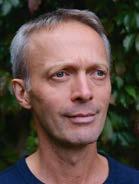
www.yoga-johnschlammes.com
www.ayurveda-johnschlammes.com
Combine cobra pose (Bhujangasana) or simple inversion poses like half shoulder stand (Viparita Karani) with calm and steady breathing.
48 YOGA









PREVENTION · REJUVENATION · REVITALIZATION · CURE Four
massages Our receptionists Thermal bath Effective pain therapies Call now for more information +49 2603 940 7- 0 info@ayurveda-badems.de · www.ayurveda-badems.de AYURVEDA CLINIC HOLISTIC HEALTH in the middle of Germany More than 30,000 satisfied guests Multiple national and international awards MAHARIS H I AY U RV E DA HEALTH CENTRE BAD EMS SINCE 1992
hand synchronous
By Ralph Steuernagel
Healing power of Ayurveda All just a question of belief?
Many people do not see Ayurveda as an effective system of medicine, likewise potentized homoeopathic remedies ("there is nothing in it") and the qi in acupuncture points ("does not exist"). However, two parties are responsible for this pejorative attitude towards Ayurveda: doctors, who do not allow alternative ways of thinking and Ayurveda providers, some of whom offer half-knowledge and esotericism without medical qualification. This reinforces the gap between western-modern and easterntraditional medicine. This is a pity, because in their synergy lies the greatest potential for prevention and therapy.
WHAT ARE THE BASICS OF A SUCCESSFUL AYURVEDA THERAPY?
Ayurveda is teamwork! More than 2,000 years ago, four pillars for successful treatment were described: doctor, nurse, medicine and patient.
Each party has to have a specific quality in addition to the best training. The doctor should have practical experience and purity of body, mind and speech. Nurses should be skillful, attentive and compassionate towards patients. Medicine must be genuine, flawless and of high quality in all its principles of action. And the patient needs a strong will to withstand therapeutic stress. If any of the four pillars weakens, the success of the therapy is in danger.
WHAT ROLE DOES THE PLACEBO EFFECT PLAY?

The subject of "placebo" is still often misunderstood. Many think of it as a random effect without scientific basis. But the placebo effect has been extensively researched, it is perceptible and measurable. A placebo effect is not based on imagination. Placebo medications inhibit our perception of pain through the release of endorphins thus alleviating, for example, the symptoms in people with Parkinson's disease. They regulate sleep disorders, reduce anxiety symptoms and lift the mood.
However, people do not react to the placebo itself, but to the meaning of placebos, situations and therapeutic conditions. An essential role is also played by experience in the context of classical conditioning, through which physical healing reactions can be learned. Particularly interesting here: placebos also work without deception, so even if we know that our "medicine" doesn't have any active ingredient and therapeutic effect, they are still effective due to unconscious processes! The mere ingestion of bitter herbs can have a great result as we often associate them with a healing medicine.
50
COLUMN _ Column _
HOW SOON CAN I EXPECT THE DESIRED EFFECT OF MY AYURVEDA THERAPY?

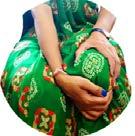
Of course, this varies from person to person and depends on other factors besides the four pillars. The duration and severity of a disease, the age and regulatory capacity of the patient, the basic constitution and imbalance have to be accounted for.
The effect of an Ayurvedic dietary change will take place after one month at the latest. In the first two weeks, adaptation reactions may occur, which we must not overestimate. Stomach and intestines, appetite and thirst, blood sugar, circulation, body temperature and sleep must first get used to the new conditions. So, if after a few days you have more flatulence than before, it is not unusual. Also your mucous membranes are not yet familiar with the new spices.
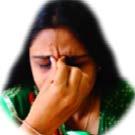
Lifestyle change: temporary adoptive reactions are also possible – for example, a change in sleeping times. Rhythm changes generally require more patience than direct measures such as hot water in the morning or tongue scraping. Exercise programmes work after a few weeks, while targeted breathing techniques work immediately.
Ayurvedic food supplements have a quick and noticeable effect on the gastrointestinal tract, often within hours or days. If, on the other hand, we want to influence internal organs, alleviate chronic joint inflammation or regulate the hormone or immune system in the long term, we need patience. Here I give three months as a time orientation after which, at the latest, the effects can be subjectively noticeable and objectively measurable.
Panchakarma therapy: here, effects can be achieved more quickly, during the course of the treatment and also in the first few weeks afterwards. However, experience shows that these effects do not last if diet, lifestyle and mindset of the patient are not sustainably changed after the treatment.
Psychological measures have the strongest causal and lasting effect of all, but they take time – weeks, months, years.
Dear critics: think outside the box a little and open yourselves to a different way of thinking, one that has endured for millennia and has proven its worth in many advanced cultures.
And to the Ayurvedic community: deep trust is very important but so is control. Don't believe everything you hear or what you are told by a guru. Check it with your own senses and a discerning mind.
No matter what our opinion is, ultimately the criterion is – who and what heals is right!
Ralph Steuernagel, as one of the pioneers of European Ayurveda, has been training therapists in his EURASIAMED Academy in Kronberg for 23 years and works with them as a coach and trainer in the establishment. In his private practice, he focuses on psychosomatics, thyroid diseases, dermatology and internal medicine.
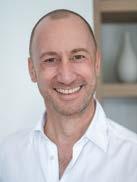
www.ayurvedamedizin.de | www.eurasiamed.de
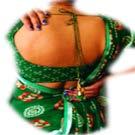
Interested to open Ayur vedic Pain Center in Eur ope? Silver Spring Building, Behind Xaviers Ladies Hostel, Navrangpura, Ahmedabad 380009 India. info@ayulink.com www.ayulink.com PA I N A N Y W H E R E
COLUMN
The courage to change
What are you waiting for?
By Verena Becker
Courage to think and be different, to take new paths and try them out. Leaving the comfort zone, learning and gaining experience that is courage. Courage that inspires and makes you happy.
This is how you can do it too!
The effectiveness of Ayurveda is influenced to a large extent by whether we have the willpower and courage to face all the challenges that Ayurvedic therapy entails. However, this is easier said than done.
We all have certain routines and habits. These give us stability and security, but sometimes they can also prevent us from going down unknown paths. We hold on to what is familiar, even if sometimes this is not good for us. The job we have been complaining about for months, the relationship we have not been happy
in for a long time or our unhealthy eating habits. We know that we have to change something, and we want to – but somehow we just can't do it. Changes can intimidate us, especially, if at first, they look like worsening the situation. Change also costs a lot of energy. That is why in times of change we need strong inner and outer resources. Here is our advice for more courage to change!

52
5 tips, to dare something new
Set goals
Sounds obvious, but it is incredibly important that we know our concrete goals. Whether alone or in collaboration with your Ayurvedic therapist – make a list and write down your goals. You can use the following five W-questions: Who is involved? Which goals do I want to achieve? When do I want it to happen? What requirements or restrictions are there to consider? Why am I setting this goal? Always have your goals visible in front of you – for example on a magnetic board on the fridge.
Small steps in the right direction
1. 2.
Great changes often appear as insurmountable barriers. This can be intimidating and quickly overwhelm us. Small partial goals meet with much less resistance. They should not be too small either but appropriate, attractive and demanding without triggering a feeling of being overtaxed.
Happiness diary
Record all small and big moments of happiness and positive emotions in a diary. You can also imagine how it will feel when you have achieved your goals. The ability to feel happiness helps to face life's upheavals with more courage and helps us cope better with negative experiences so you always have it in black and white!
4.
Get started today
"At the moment it doesn't work because..." Change can only happen now. Ask yourself: "What can I do today to get one-step closer to my goal?"
Let go and focus on the here and now
3. 5. THE COURAGE TO CHANGE
WE WISH YOU MANY SMALL AND GREAT MOMENTS OF HAPPINESS ON YOUR PATH OF CHANGE. HERE WE GO!
Worries about possible consequences of imbalance, fear of failure – stay in the here and now. Feel the body; be aware of your feelings. What do you feel, what do you see, smell, taste and hear right now? Try to get in touch with what is actually happening and what you can influence at this moment. 53
Covid -19:
Why so few recommendations for strengthening the immune system?
 By Ernst Schrott, MD
By Ernst Schrott, MD
The federal government's strategy in the corona endemic is focussed almost exclusively on two areas:
• Protection against infection through various measures such as compulsory masks, keeping a distance and hygiene measures
• Vaccination.
On the other hand, measures to strengthen one's own immune system are hardly considered and certainly not recommended as a third measure, either by the virologists advising the government or by the responsible politicians. There is little doubt in scientific medicine about the great importance of the body's own immune system as a protective mechanism against infectious diseases in general and against Covid-19 in particular.
From the point of view of the German Society for Ayurveda e. V. (DGA) it appears to be an incomplete package of measures. We consider a holistic and, above all, preventive approach urgently necessary. Ayurveda, which is now used worldwide and recognised by the WHO as a traditional healing system, has a wealth of experience in the use of natural medicines and therapies, especially for the prevention and treatment of infectious diseases.
SCIENTIFIC STUDIES IN CONNECTION WITH COVID-19
In an effort to find effective medicines against the Covid-19 infection and disease, numerous synthetic and naturally occurring substances have been scientifically and clinically tested. While anti-malarial drugs and conventional virus inhibitors showed no or only unsatisfactory effects, two traditional Ayurvedic medicinal plants have proven to be a promising source.
LIQUORICE ROOT - POTENTIAL MEANS OF PROTECTION AGAINST SARS CORONA VIRUSES
As early as 2003, scientists at the University of Frankfurt demonstrated that glycyrrhizin from the liquorice root inhibited the replication of SARS corona viruses. Researchers from the Medical School of Hong Kong and University have now discovered a further protective mechanism against the current corona virus. Glycyrrhizin can block the entry ports for SARScorona viruses at ACE2 receptors in the lungs and thus prevent the virus getting into the organism.
54
COVID-19
ASHWAGANDHATRADITIONAL AYURVEDIC MEDICINAL PLANT INHIBITS KEY ENZYME TO BLOCK VIRUS REPLICATION
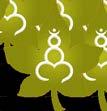
Indian scientists found that the active ingredient withanoside V from the root of withania somnifera (ashwagandha), blocks the key enzyme (M pro), which is responsible for the multiplication of the virus in the organism.
ACTIVE INGREDIENT COMBINATION OF LIQUORICE AND ASHWAGANDHA
Both medicinal plants are traditionally used in Ayurveda medicine to strengthen the immune system against infections caused by viruses and germs. Both plants have additional effects that protect against respiratory tract infections and support the healing. They have an anti-inflammatory effect, immune-strengthening and are cough-soothing and toning. An Ayurvedic preparation containing the active ingredients of the two plants is available as a traditional local dietary supplement via the internet and in pharmacies in Ger -
many without a prescription. It has been prescribed by doctors who are familiar with Ayurvedic medicine for years as a preventive measure to strengthen the immune system and as a supportive treatment for viral respiratory infections. For patients with Covid-19 disease, who were in quarantine at home, this combination of active ingredients has proven successful.
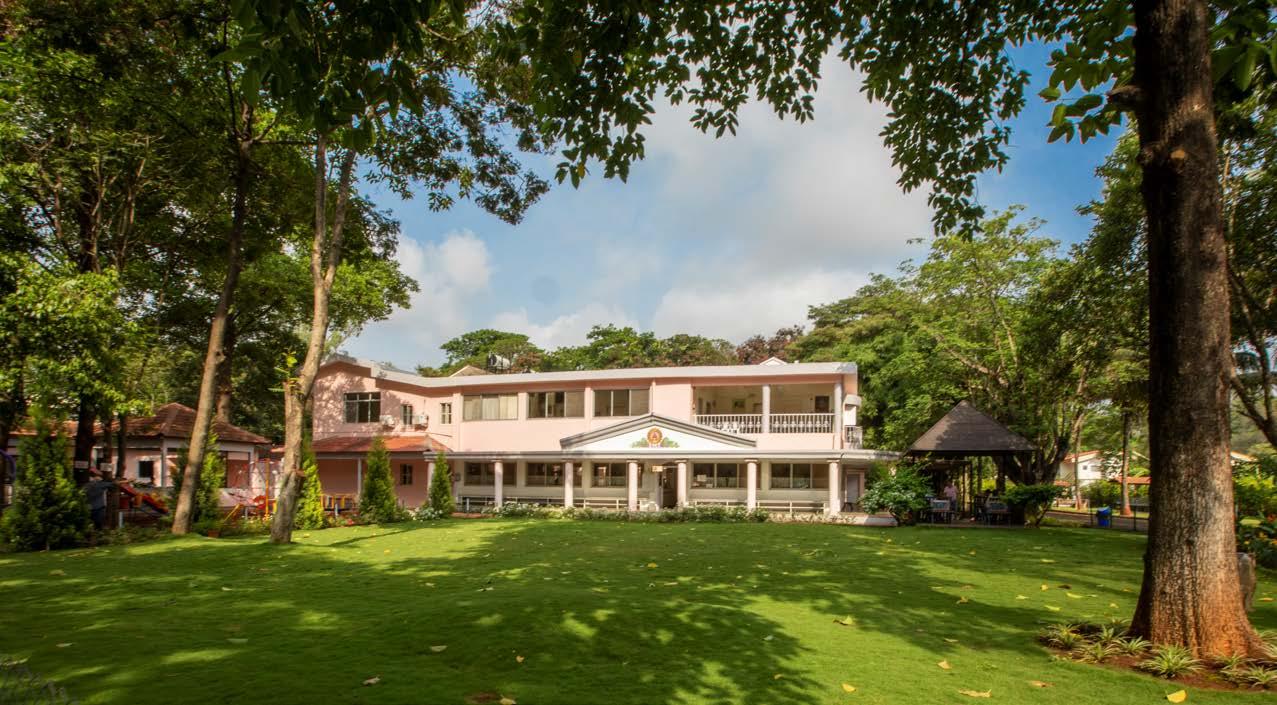
Incidentally, this phytocombination was offered by the Indian government at the beginning of the Covid-19 pandemic, along with three other herbal preparations.
ANTIVIRAL PROPERTIES OF THE GINGER ROOT
In addition to numerous other natural substances, the active ingredients of ginger root, a medicinal plant frequently used in Ayurveda to strengthen the immune system, also reduce the multiplication of viruses in the body and reduce the risk of infection. Moreover, ginger is not only effective against viruses but also against pathogenic bacteria and it strengthens the immune system.
Atmasantulana Village Near MTDC Holiday Resort Karla - 410405 (near Lonavala) Dist: Pune, India www.santulan.in Santulan AUM Kurzentrum near Stuttgart, Germany www.ayurvedakuren.com •
is the best way to detoxify, cleanse and rejuvenate
globally renowned Ayurvedic doctor
• P u r e l y v e g e t a r i a n m e a l s b a s e d o n Annayog - the Santulan concept of diet and food. • I n t e r n a t i o n a l Te a m o f e x p e r i e n c e d doctors and therapists. • T h e d a i l y p r o g r a m i n c l u d e s y o g a , meditation/music therapy and lectures. Traditional Panchakarma Healing Centres In India since 1982 And Germany since 1994 ®Santulan Ayur veda
Santulan Panchakarma
yourself. • Founded by Dr Shri Balaji Tambe, a
and author of several books.
Life in Balance
COVID-19
VITAMIN C, VITAMIN D3 AND ZINC
Vitamin C, vitamin D3 and zinc are well known active ingredients for a functioning immune system. The English government is currently considering using vitamin D3 as a preventive measure to strengthen the immune system and against Covid-19, and has commissioned scientists to recommend dosages for the general population. As the British newspaper The Guardian reported in its edition of 14 November 2021, the government led by Prime Minister Boris Johnson recommended the use of food supplements. In addition, groups at risk are to receive vitamin supplements free of charge. In Scotland this is already the case.
LIGHT, AIR, SUN, EXERCISE AND SPORTEXTREMELY IMPORTANT FOR A HEALTHY IMMUNE SYSTEM.

A video commissioned by the German government encouraged young people to stay at home during one lockdown spending time on the couch, eating junk food in front of the TV. This is well-intentioned to minimize contact with each other and thus reduce the infection rate. However, this kind of leisure time activity is probably not good for health. It is also questionable whether young people, in view of the lockdowns, company bankruptcies and job losses as well as the worries associated with them, feel addressed by such a video.
On the other hand, during the first lockdown, virologists explicitly recommended spending time in fresh air and sunshine, combined with individual sports, because this is known to promote health and strengthen the immune system.
FEAR WEAKENS THE IMMUNE SYSTEM
During the pandemic we were experiencing a division in the population, which was also reflected in the daily conversations and discussions with patients in many medical practices. Fear on one hand and an increasing rejection of the corona protection measures on the other are responsible. Negative emotions such as persistent fears, worry, hopelessness and loss of confidence are proven to weaken the immune system.
Whilst understanding the need for the measures and education to protect the population, politics and the media have a special responsibility here to use with conviction a language of hope, confidence and trust. A beneficial and confidence-building step in this direction would be for the politicians, in consultation with experts from various medical disciplines, including representatives of recognized associations of complementary medicine, to evaluate possibilities for strengthening the immune system and provide the population with suitable measures as a third strategy to protect against corona.
Ernst Schrott, MD has practised naturopathy in Regensburg from 1984 until 2021. He is known throughout Europe for his publications and bestsellers on Ayurveda and Vedic technologies of consciousness and his extensive lecturing and and teaching activities at home and abroad. Dr. Schrott was co-founder and vice-president of the German Society of Ayurveda and director of the German Ayurveda Academy.

56
COVID-19
NasyaFinally breath free
By Wiebke Abel
Nasya in Ayurveda refers to the cleansing of the paranasal sinuses and the care of the nasal mucous membranes. It is one of the five forms of treatment of the classical ayurvedic panchakarma. This procedure uses oils, herbs, decoctions or smoke and herbal vapours. In the panchakarma therapy, nasya is mainly used to eliminate excess kapha in the form of mucus and a cold in the head area. Nasya oils can also be used for the daily care of the mucous membranes as part of an Ayurvedic daily routine outside of a panchakarma.

57
NASYA
According to the Sushruta Samhita, which is one of the most important works of Ayurvedic medicine, the nasya, depending on whether the type of treatment is nourishing or purifying, promotes clarity of mind and beauty of the face and strengthens all the sensory organs. According to Ayurveda, nasya has an effect on all nerve connections above the collarbone. The nose is also considered the "gateway of the head". Many imbalances in the head area can be resolved by first treating the disturbed doshas with heat and massage and then removing them through the nose.

TYPES OF NASYA
There are five different types of nasya that are used as a part of an Ayurvedic treatment. In the first variation, the snehana nasya, medicated oils or ghees are placed in the nostrils, such as anu thailam, triphala ghee or simple ghee. This form of nasya can be given for all conditions. Depending on how many drops are given, the nasya can be gentle, medium or intense.
In the second variety, a decoction or juice is made from special plants which is then put into the nose in the form of droplets. This variation can be used particularly for nosebleeds (raktapitta) or unconsciousness in the case of an epileptic seizure.
In the third modification, herbal powder is inhaled through a pipe or blown into the nose. Alternatively, the powder can also be inhaled as a kind of snuff. Conditions for this modification are confusions of the mind, epilepsy and headaches caused by parasites. One possible herbal mixture for this consists of black pepper, ginger and cloves.
The fourth form is the inhalation of smoke through the nose. This smoke treatment can be given before the nasya, when kapha is in an acutely elevated state, or following a snehana nasya. Certain herbs such as pippali (long pepper) or vaca (calamus root) are placed on hot coals and the resulting smoke is inhaled. It is easier to smoke ready-made herbal cigarettes!
While the first four variations of nasya should only be performed under the supervision of a trained therapist, the last version can be performed alone and is used for daily care. For this, apply two drops of suitable oil on the mucous membrane of the nose with your finger.
This form of nasya can be performed by all constitutions up to twice a day. It is considered beneficial for health in all seasons and can be given from birth to death. Recommended for people on whom a more intensive nasya cannot be performed, such as for children, the weak, the elderly or very sensitive people.
The following indications and contraindications for treatment apply to the more intensive forms of nasya, which can only be performed as part of an ayurvedic treatment.

INDICATIONS
• Neck pain
• Toothache
• Lock jaw
• Sinusitis
• Chronic rhinitis
• Chronic fatigue
• Migraine
• Shoulder pain
• Sensitive teeth
• Eye diseases
• Headache, sore throat, earache
• Tinnitus
Contraindications include digestive disorders, cough, acute rhinitis, pregnancy, fatigue, children under seven and senior citizens over eighty years old. Consult an experienced therapist or doctor to find which form of nasya is most suitable for you.
HOW IS NASYA PERFORMED?
In my practice I always administer the snehana variant of nasya. At the beginning of the treatment an intensive head massage with oil (shiroabhyanga) is
58
NASYA
carried out to activate the kapha. The shoulders, the head and the face are massaged with a little oil. This is followed by inhalation with Ayurvedic herbs and application of warm and moist compresses. Depending on the constitution, a suitable amount of the medicated oil is then dropped into the nose. The mucus that is loosened is spat out through the mouth. The nose should not be blown until the treatment is finished, so that the oil can work for as long as possible. Finally, warm compresses are again applied to the face, followed by gargling with salt water to loosen further mucus.
After the treatment, it is important to rest sufficiently. A shower should only be taken after two to three hours and the head should always be covered when you go outside. Wind and strong sunlight should be avoided, as should prolonged reading, watching television, computer work or other mental exertions. A light and balanced diet is recommended to celebrate the success of the treatment.
SIGNS OF A SUCCESSFUL APPLICATION
• Lightness of mind
• Deep sleep and easy waking
• Reduction of problems
• Clarity in the senses and mind
If the problems are persistent, the treatment should be repeated up to seven times. Between the individual treatments, there should be a break of one to three days. Particularly in the case of chronic sinusitis it is advisable to perform a set of at least three nasya sessions.

If you have allergies, you should also plan several sessions and it is best to start treatment before the onset of the allergy season. Conventional medicine offers few solutions, apart from cortisone or surgery, for chronic complaints such as allergies, tinnitus or migraines. It is well worth trying out this alternative, which is intensive yet gentle in comparison.
Wiebke Abel is an anthropologist / indologist (M.A.). She works as a non-medical practitioner, Ayurveda consultant and therapist in Hamburg.
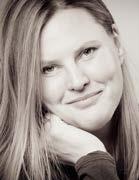
www.svasthya.de

59
NASYA
MEAT CONSUMPTION FROM AN AYURVEDIC PERSPECTIVE

Answers beyond yes or no
By Dr. Shubhangee Satam
In Ayurveda, the ancient science of life, a constitutionally appropriate diet is considered an important component in maintaining health. Meat consumption is not excluded in the ancient scriptures. But there are precise ideas about what meat can be eaten by whom and when and of what quality it should be. Besides this detailed knowledge, in India, the motherland of Ayurveda, there are also ethical and religious references regarding the consumption of meat. But, let's start with the ancient scriptures and traditions.
CATEGORISATION IN THE ANCIENT SCRIPTURES
In Ayurveda, food is divided into different categories, such as groups of grains, pulses, leafy vegetables, meat, fruit, etc.
The meat category includes poultry, mammals and fish. These are in turn subdivided into groups according to habitat and feeding habits. The general characteristics of these meat subgroups and individual animals are described in detail in the ancient writings.

60
THE MAIN GROUPS IN MEAT ARE:
1. meat from animals that live in dry and forest areas
2. meat from animals that live in water or wetlands.
These groups are in turn divided into various subgroups. The characteristics of the different groups and of individual important poultry species and mammals are described. For quadruped animals, the general rule is that the meat of females is more difficult to digest than that of males, while the reverse is true for poultry.
THE AYURVEDIC EFFECT OF MEAT
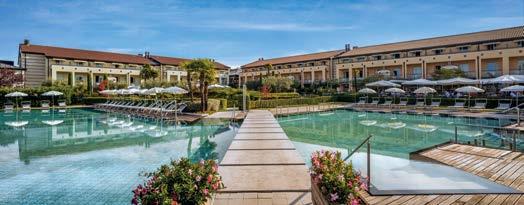
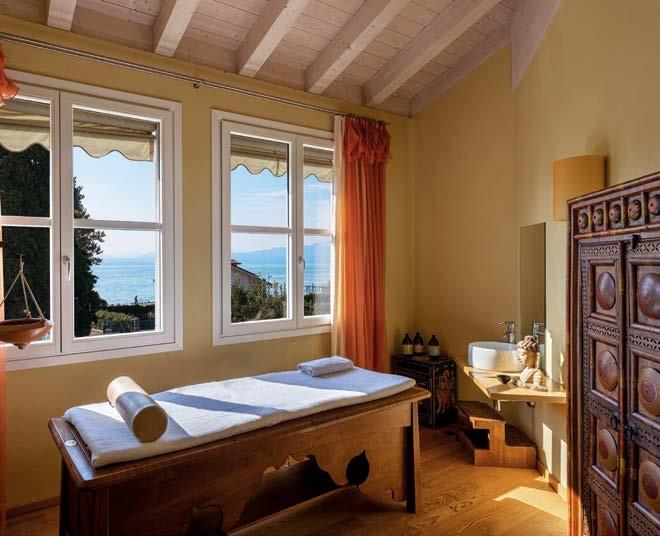
If one wants to summarise the effect of food in general simply, it can be said: "meat promotes growth" and "meat soup nourishes".
Meat is considered sweet in terms of taste and digestive product. It promotes growth, takes time to digest, is nourishing and soothes vata. It is said that no other food is as nourishing as meat.
According to Ayurveda, the meat of animals living in arid regions and forest areas is cooling in effect, easily digestible and is recommended for disorders affecting all three doshas (with a dominance of pitta, moderately elevated vata and slightly elevated kapha). In terms of taste, the meat of this group is considered sweet and astringent, dry, invigorating, growth-promoting and vitality-enhancing. It kindles the digestive fire and is recommended for disorders and imbalances of vata.
The meat of animals that live in wetlands is sweet to the taste. It is oily-moist, takes time to digest, dampens the digestive fire a little, is mucilaginous, nourishes the muscles, strengthens kapha and is generally beneficial to health.
WHAT QUALITY SHOULD THE MEAT BE?
In terms of meat consumption, ayurveda recommends eating meat from animals/poultry that have been freshly slaughtered. It should not be contaminated and should come from adult animals that live in a natural environment appropriate to their species. Meat from animals that died of natural causes, were severely emaciated, were excessively fat and from animals that died of disease or in accidents such as drowning or poisoning should not be consumed.
61
Ayurveda Lake
www.hotelcaesiusterme.com CAESIUS THERMAE & SPA RESORT 37011 Bardolino (VR) - Tel. +39 045 7219100 www.hotelcaesiusterme.com MEAT
The Hotel Caesius Thermae & SPA Resort is a temple of well-being on the lakefront, set amongst the beautiful nature of Lake Garda. It was the first resort in Italy to open a fully equipped Ayurvedic spa offering an authentic Ayurveda experience. The Mediterranean scenery of Lake Garda is the perfect setting for an Ayurveda retreat. The mild climate, clean air, magnificent views, and the pure spring water of the hotel’s thermal water center will complete your journey towards well-being.
Garda, Italy
Meat from factory farms does not meet the recommendations of Ayurveda. Animals that grow up in factories do not live in their natural environment. On the contrary, they grow up in terrible conditions, are treated with medicines and may be sick. Often the meat is frozen after slaughter and only reaches the consumer weeks later. These are all things that were unimaginable several thousand years ago, when Ayurveda was developing and forming.
THE SPIRITUAL DIMENSION
Also for spiritual reasons (not only in India) many people do not eat meat. Eating meat promotes tamas, i.e. dullness and inertia, and can thus be an obstacle on the path to attaining higher states of consciousness. From a spiritual point of view, meat consumption contradicts the principle of non-violence towards all living beings and keeps humans trapped in the cycle of rebirth according to an ancient Indian scripture on appropriate behaviour (Manusmriti). This applies in particular to the consumption of pork.
THE SPECIAL ROLE OF CHICKEN MEAT
Ayurveda pays special attention to chicken meat. It is one of the foods that Ayurveda believes can be consumed regularly. Chicken belongs to the category of fowl. These animals scratch at the food before eating it. In general, the meat of this group is easily digestible, cooling in effect and sweet and slightly astringent in taste. As a digestive product, it is pungent. It strengthens the body, is an aphrodisiac and is healthpromoting. It supports the healing of diseases responsible for the vitiation of all three doshas (highly vitiated pitta, moderately vitiated vata and slightly vitiated kapha).
Chicken in particular is oily-moist, warming and astringent to the taste. It promotes sweating and pacifies vata. However, it takes time to digest and requires a well-functioning agni (digestive fire). It strengthens the body, builds muscles and nourishes the shukra dhatu. The meat of domestic chickens usually increases kapha and is more difficult to digest compared to the meat of wild chickens. The meat of game hens is oily-moist. It also increases kapha, pacifies vata and pitta, promotes growth and is recommended for states of weakness.
CHICKEN EGGS

Chicken eggs are described in Ayurveda as a remedy, for immediate strengthening. They are sweet and do not cause burning. Interestingly, Ayurveda also uses the eggshell in the form of bhasma (mineral ashes, which are only partially allowed in Germany) as an excellent source of calcium. As a source of calcium, bhasma improves bone density and is also used for osteoporosis and its precursors. It is also used as a supportive ingredient during menopause.
CONCLUSION: SEVERAL FACTORS PLAY A ROLE
Overall, it can be said that chicken nourishes, promotes growth, soothes vata and tends to increase kapha. It is therefore preferred for states of aggravated vata and a constitution with dominant vata. However, caution is advised in a constitution with dominant kapha and conditions of aggravated kapha such as high cholesterol, obesity, etc. So eating chicken can have a positive effect in some cases. However, like so much in Ayurveda, this is not an absolute truth, but must be individually assessed and weighed in relation to the constitution.
Dr. Shubhangee Satam M.D. (Ayurveda) is an Ayurvedic physician and expert in the field of Dravyaguna and has many years of experience in both clinical practice and Ayurvedic pharmacy. She works as a consultant for leading international Ayurvedic pharmaceutical companies and is active as a course leader in Europe and the USA.
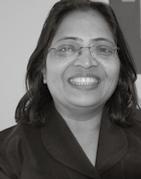
MEAT 62
Ayurvedic Desserts for all three doshas
Nourishing & grounding
By Julia Wunderlich

They can be found in every temple, at every bus station, no matter how remote – the confectionery stalls in India. Boiled milk confectionery, deep-fried sugar rings in bright colours and they belong to a thali anyway: desserts. However, are sweets "Ayurvedic"? And when or if at all, should they be eaten?
The sweet taste plays a central role in Ayurveda, both in grains as well as in ripe, sattvic fruits and in desserts that are consumed in temples or at festivals and because of its special qualities as an elixir of life. Desserts are madhu rasa, that is, of sweet taste. The sweet taste has a cooling effect and brings with it the two elements of earth and water. Thanks to these cooling and restorative properties, Ayurvedic desserts provide suppleness, moisture and nourishment on both a physical and mental level.
SWEETENERS IN THE CONTEXT OF EFFECTIVE NUTRITIONAL THERAPY
It is advisable to choose sweeteners consciously and to adapt them to one's own constitution. Sharkara, the classical Ayurvedic sugar, is said to have an alkaline effect. In contrast to industrial sugar it is not hot and over-acidifying. It is especially recommended for vata and pitta types and is also recommended for its Ayurvedic balancing effect. It is also found in Ayurvedic rasayanas (Ayurvedic tonics).
In addition, the classic pitta type may sweeten with coconut blossom sugar and dates but less with honey. Because of its warming effect, honey is ideal for kapha constitutions. Jaggery, dates and mild maple syrup are particularly suitable for vata types because of their balancing effect.
Since the sweet taste brings coolness and heaviness, it is advisable for vata and kapha diets. It is recommended to combine desserts with warming spices to stimulate agni and improve digestibility.
Julia Wunderlich
is a South Asian scientist, Ayurvedic nutrition advisor, meditation teacher and a Vedic coach for women. In individual sessions and workshops, Julia accompanies women on their self-determined path. She shares her knowledge and experience in her project, Rolling Tiger. www.rollingtiger.org

RECIPES - NOURISH AND STRENGTHEN 63
PITTA: Rose Pannacotta with Happy Pitta Granola

Pitta types need coolness and moisture to recharge and regenerate.
VATA: Kaju-Sheera with Saffron-Apricot
This Vata-balancing dessert is grounding and rich in sensuality.

Ingredients for 2-4 people:
For the Sheera
2 cardamom pods
2 cloves
5 tbsp rice semolina (or spelt semolina)
2 tbsp sultanas
2 tbsp cashew nuts
400ml rice milk
1 pinch of salt
1 tbsp jaggery
Preparation:
For the fruit
4 apricots (fresh or dried)
4 strands saffron
1 pinch of cinnamon water
Grind the saffron and pour a little cold water over that and set aside.
Pound the cardamom pods and cloves in a mortar. Heat the ghee in a saucepan and then add the mortared spices, toss briefly in the hot fat. Then add the semolina and sweat in the fat. Add the sultanas and cashews and continue to sweat. Deglaze with rice milk and stir with a whisk to prevent lumps from forming. Add salt and jaggery over a low heat for about five minutes. Simmer for about five minutes. Meanwhile, wash and dice fresh apricots. If using dried apricots, soak them briefly in hot water. Stew the apricots in a little water, with the saffron and the cinnamon in a covered saucepan. Add date sweetener or jaggery to taste.
Divide the sheera into bowls and garnish with apricots.

Tip: instead of jaggery, you could add a mashed banana.
Ingredients for 2-4 people:
For the Granola
100g oatmeal (or rolled oats, small leaf)
50g pumpkin seeds
50g sunflower seeds
25g coconut flakes
2 tbsp linseed
2 tbsp coconut fat
2 tbsp date sweetener
1 tsp cinnamon
a little cardamom
2 pinches salt
1-2 tbsp rose petals
64 REZEPTE RECIPES
Ingredients for 2-4 people:
Handful of grated coconut (small)
1 ripe tomato, medium size
1 shallot
3 tbsp mung beans
1 tbsp jaggery
1 tsp garam masala
Rock salt
Lime juice
1 tbsp ghee
For the pannacotta
150ml coconut milk
150ml almond cream
1 tbsp sharkara
¼ tsp cardamom, ground
1 tbsp rose water
1 tsp lime juice
1.5 tsp guar gum
For the fruit

For example: plums, sharkara and cinnamon
KAPHA Moong-Usal

Ideally, desserts suitable for Kapha contain a lot of fruit, few grains and little sugar. Mung beans are also wonderful for preparing easy digestible desserts for Kapha types.
Preparation:
The mung beans should be soaked for eight hours beforehand. Wash the mung beans thoroughly and simmer them with three times the amount of water in a closed pot - cook for at least 25 minutes. Meanwhile, wash, halve and seed the tomato and cut into small cubes. Peel and dice the shallot. Heat the ghee in a non-stick pan and add the shallot and tomato and let simmer for eight minutes. Then add the grated coconut and cook over a low heat with the lid on for another eight minutes. Allow the mixture to cool down slightly.
Add the mixture, salt, jaggery and garam masala to the mung bean pot and simmer for about five minutes. Season with a little lime juice if needed.
Preparation:
For the granola, place all the ingredients, except the rose petals, in a bowl and mix with your hands. Bake in a preheated oven at 200 degrees for ten minutes. Turn every now and then. The granola should not get too dark. Then leave to cool and mix with the rose petals.
For the pannacotta, combine the coconut milk, almond cream, sharkara, cardamom, rose water and the lime juice in a bowl. Pass the guar gum through a sieve and continue to mix with the mixer. Pour into small bowls and refrigerate for 30 minutes. Serve the granola with the pannacotta. For the stewed plums: wash, halve and core the plums and simmer with a little water, sharkara and cinnamon.
65 RECIPES
Order the Ayurveda Journal International in our online store!
Simply order your print & digital edition here: www.ayurvedajournal.shop
Responsable Editor:
AYUSmedia UG, Störtebekerweg 83, 21149 Hamburg, email: info@ayusmedia.com, website: www.ayurvedajournal.world
Chief executives: Carmen Menzel, Dr. Shubhangee Satam
District court: Hamburg B 151220
Tax no.: 47/704/02439, VAT no.: DE319620330
Editorial management: Verena Becker email: editorial@ayurvedajournal.world
Advertising service: email: ads@ayurvedajournal.world
Publisher, Production and distribution:
Ayus Publications e.K., Postfach 1416, 21251 Tostedt email: info@ayuspublications.com
Registry court: district court Tostedt, registry no.: HRA 201810
IMAGE SOURCES
Cover / Trinette Reed / Stocksy United
Page 8-10 / Liliya Rodnikova / Stocksy United
Page 12 / Gavin Hellier / Stocksy United
Page 14 / Colin Anderson / Stocksy United
Page 16 / Marina Demidova / shutterstock
Page 17 / Sergey Filimonov / Stocksy United
Page 18 / Rocky89 / istock by Getty Images
Page 22 / krutar / shutterstock
Page 24 / Ani Dimi / Stocksy United
Page 26, 28 / ChaoShu Li / Stocksy United
Art direction, layout, typesetting: Ayus Publications e.K. in cooperation with Jutta Fleischer, Nicola Hartmann
Image copyright: Ayus Publications e.K.
Subscriber management: email: subscription@ayurvedajournal.world
Single issue distribution: www.ayurvedajournal.shop

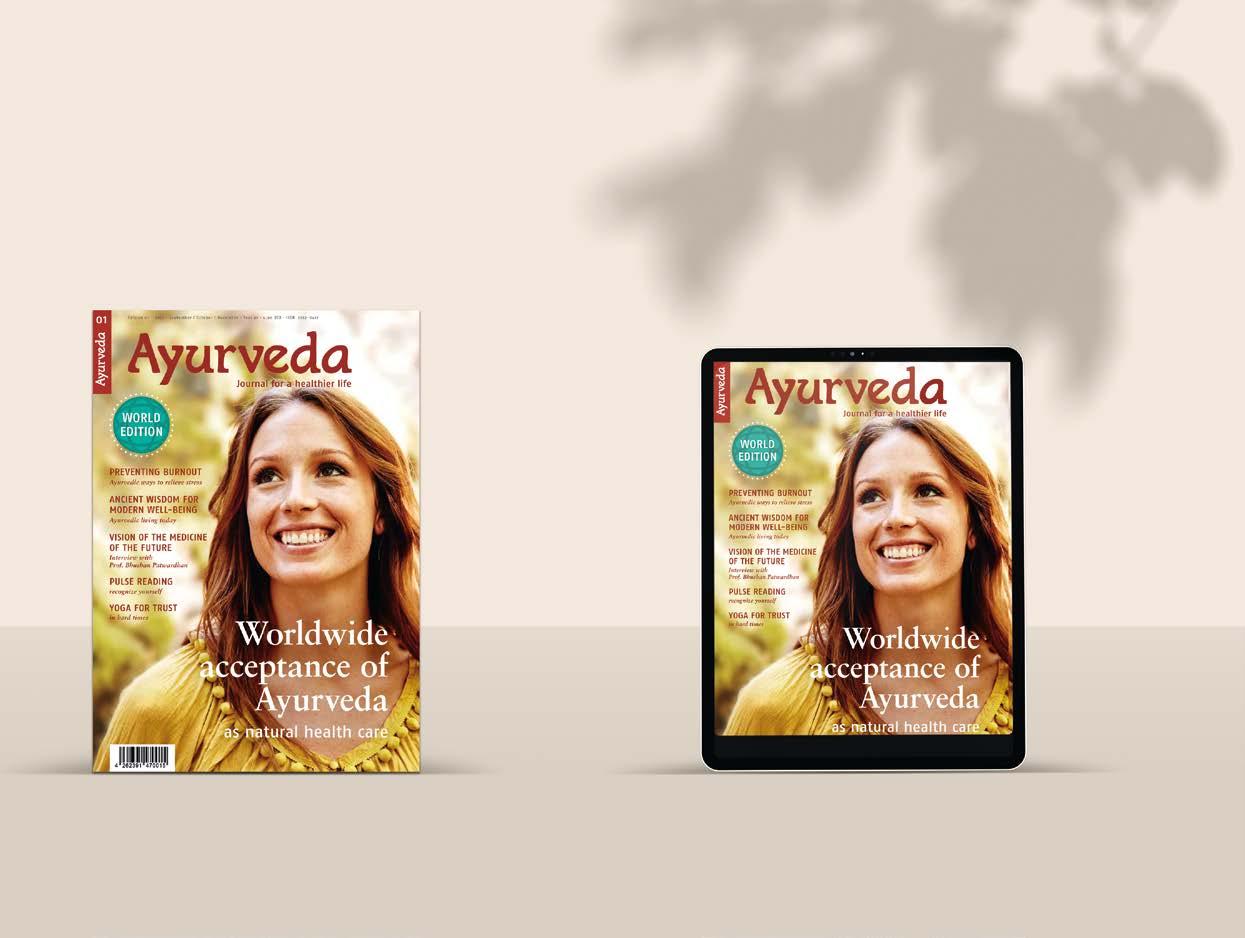
© Copyright: All rights reserved. Copyright by Ayus Publications. Articles marked with the author's name do not necessarily represent the opinion of the editorial staff. The magazine and all articles contained in it are protected by copyright. No part of this journal may be reproduced in any form (print, photocopy, microfilm, computer, Internet, etc.) without written permission from the publisher.
Neither the editors nor the publisher can accept any liability for dosages and application instructions for herbs or preparations or for therapeutic recommendations. All information must be checked by the user.
Page 28 / Pansfun Images / Stocksy United
Page 36 / Dr. Schrott
Page 40 / Kryvenok Anastasiia / shutterstock
Page 40, 41 / Transia Design / shutterstock
Page 42 / Utro_na_more / istock by Getty Images
Page 43 / gustyx / istock by Getty Images
Page 46, 48 / Lumina / Stocksy United
Page 48 / ZHPH Production / Stocksy United
Page 50 / successo images / shutterstock
Page 52 / Gillian Vann / Stocksy United
Page 54 / tatianazaets / istock by Getty Images
Page 56 / Dudarev Mikhail / shutterstock
Page 57-59 / Jacob Wackerhausen / istock by Getty
Images
Page 58 / Nina Lishchuk / shutterstock
Page 60 / Oksana Mizina / shutterstock
Page 60, 62 / Illustration: Jessica Sprenger / schebbs
Page 63 / Liliya Rodnikova / Stocksy United
Page 64, 65 / Alita Ong / Stocksy United, Julia Wunderlich
Print edition Digital Edition
66
IMPRINT
Page / Image source Page / Image source Page / Image source Single issue digital 3,90 USD One year digital subscription4 issues 14,90 USD One year print subscription - 4 issues incl. postage 35,80 USD Single issue print 4,90 USD + postage
ANCIENT WISDOM FOR MODERN LIFE
Bring balance to your mind, body and emotions with our time-proven herbal remedies.
BALANCED RESTORED
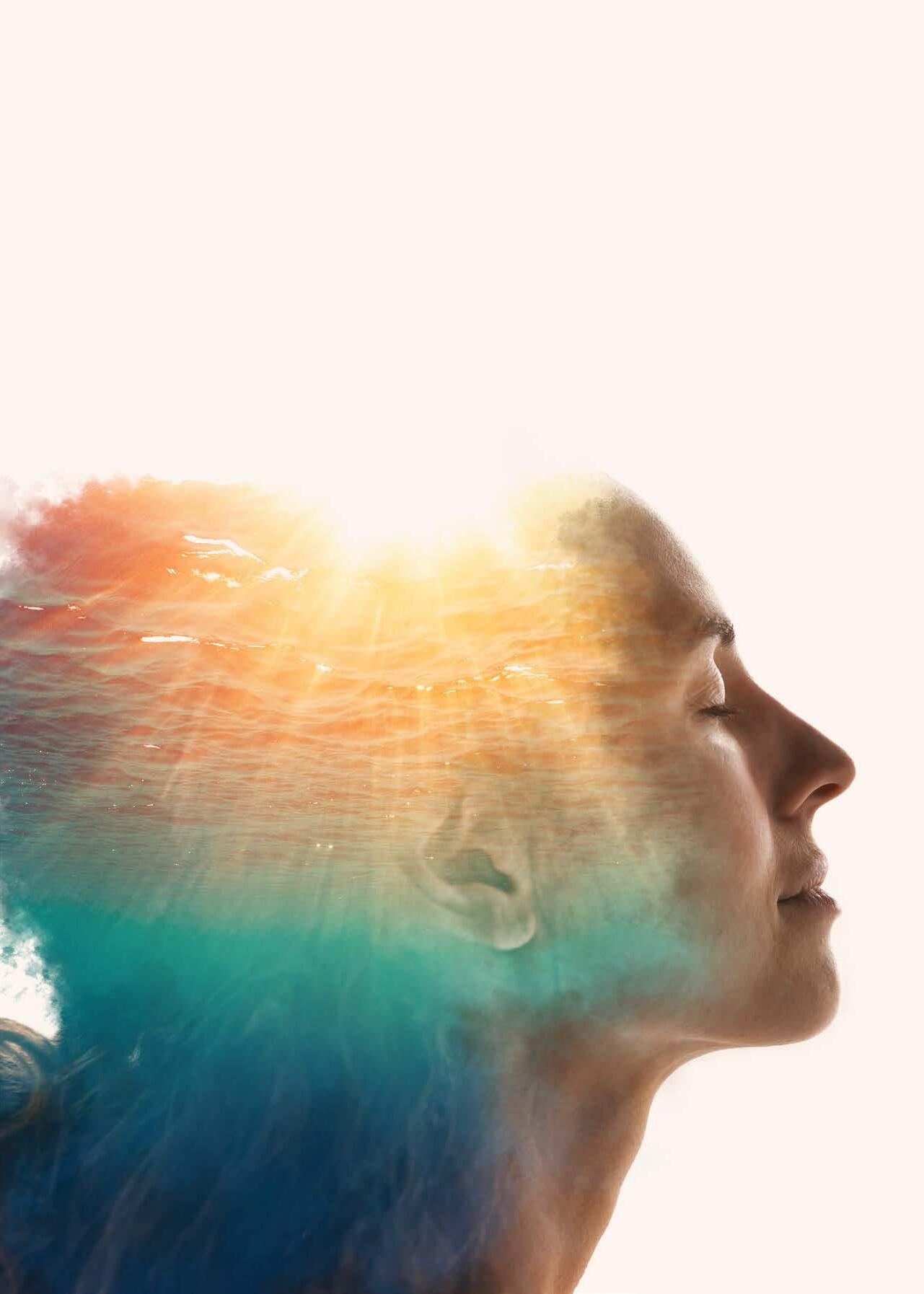
MAPI.COM
AYURVEDA experience Your
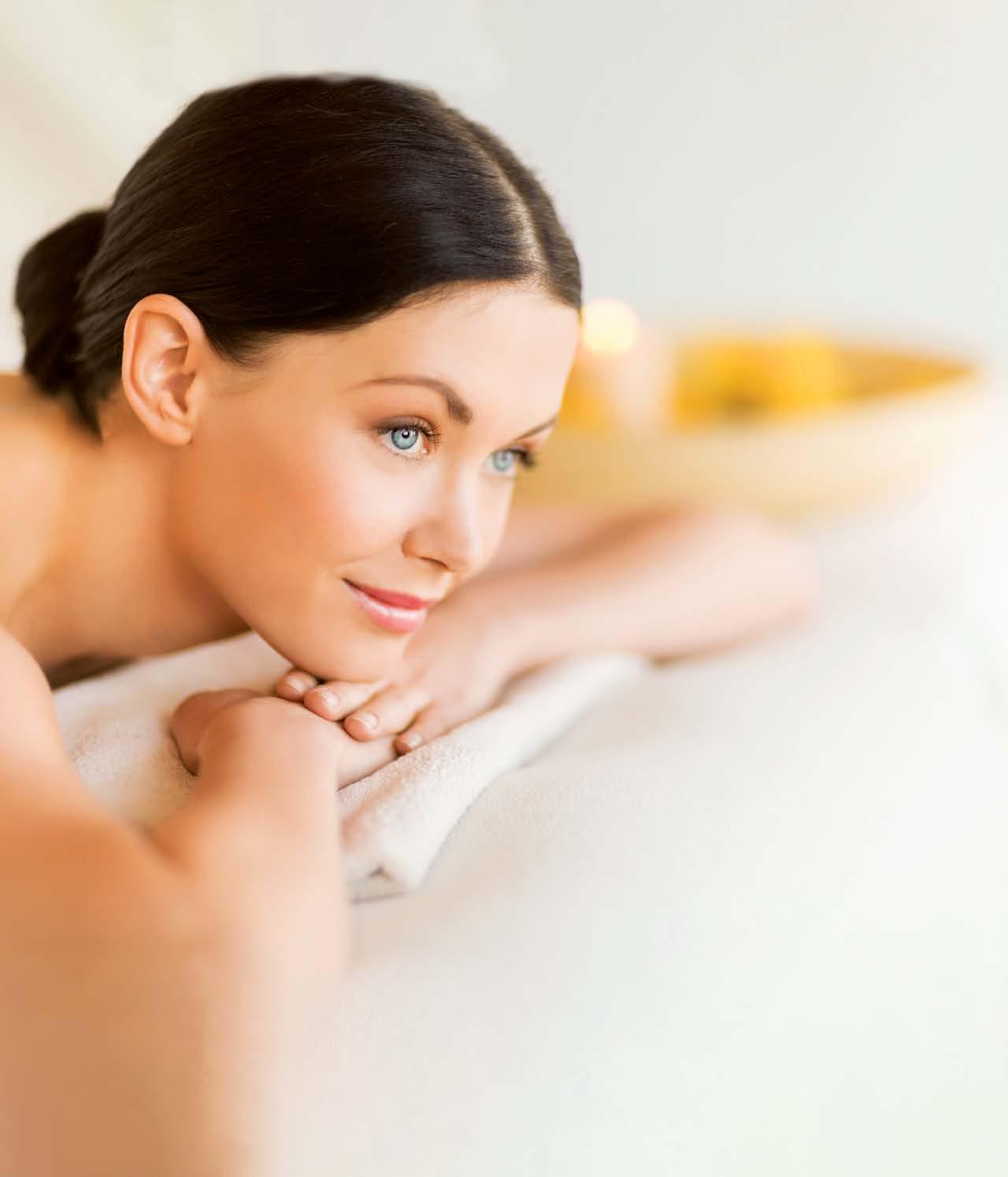
...in Europe‘s largest seminar houses for yoga, meditation and Ayurveda
Ayurveda Medicine: Advance Training with Dr. Devendra Prasad Mishra
Oct 14 - 23 2022 from 780,00 €
Panchakarma Group cure with Dr. Devendra Mishra
January 8 - 22 2023 from 1.143 €
Advanced Yoga Teachers’ Training Prana – scientific and spiritual with Harilalji
Nov 11 - 18 2022 from 480,00 €





Ayurveda cooking for seasons with Dr. Devendra Prasad Mishra
Autumn season - Oct 28 - 30 2022
Winter season - Feb 3 - 5 2023 from 155,00 €
The hidden language of the Asanas with Swami Sukhananda
Dec 25 - 30 2022 from 323,00 €
FOR MORE DETAILS
YOGA VIDYA Seminar houses
Bad Meinberg · Westerwald · Nordsee · Allgäu
Email: info@yoga-vidya.de
Phone: +49 5234 / 87-0
WWW.YOGA-VIDYA.ORG/ENGLISH
















































 By Carina Alana Preuß
By Carina Alana Preuß
 By
By
 By Petra Rascher
By Petra Rascher
 Ernst Schrott, MD
By Julia Wunderlich
Ernst Schrott, MD
By Julia Wunderlich





















































































 By Verena Becker
By Verena Becker
















































































































 By Ernst Schrott, MD
By Ernst Schrott, MD































